|
Chapter 3: Conversely, the Twelve Also Reveals the Thirteenth -or- The Strange Congruence
|
|
by R. Russell Kinter, Copyright 2015 |
|
|
|
Chapter 3: Conversely, the Twelve Also Reveals the Thirteenth -or- The Strange Congruence
|
|
by R. Russell Kinter, Copyright 2015 |
|
|
Quick Links: Introduction Specifics to Chapter 3 Catalog of Terminal Vector States Seventy-eight Total Strange Congruence
A Likely Story Dissolve and Coagulate Summary and Implications Appendix A Appendix B Appendix C Appendix D
Helpful Technical Info:
1. These pages are best viewed at a desktop of 1078 x 768 or higher.
2. It can be helpful at times to view this site at full-screen. Press 'F11' to both enter and exit full-screen mode in your internet browser.
3. Use the "Back" button (or right-click and select "Back") of your internet browser to go back where you left off when following bookmarks and links.
4. JavaScript must be enabled to run the very simple scripts for animations. Unfortunately, Internet Explorer may raise a fuss, so you will have to grant permissions when ever it throws a flag.
5. These pages are very graphics intensive and were written on a PC, so they may not work so well on phones and tablets!
6. The web page is at a disadvantage when it tries to convey three-dimensional information using two-dimensional images. Consequently, as many relevant images as possible have been included to try to make the presentation clearer. However, a willingness to concentrate is also required make the leap from two dimensions to three!
7. A majority of the terms for the geometric shapes have been invented for these pages and are probably different from the mathematicians' terms for the same constructions.
8. Questions may be e-mailed to: pyth7(_@_)verizon.net (remove the brackets and underscores).
More Background on this System
It is necessary to delve a little further into the "why's" that maybe plaguing the reader, because a retort of "why not?" may not be sufficient.
Q: What advantage does this admittedly complex system have over a simple shuffled deck?
A: Nothing for doing readings per se, especially if time is limited. This system is an experiment at a philosophical machine in the tradition of Raymond Lull and the word "experiment" can not be over emphasized! This quote from the chapter on Tarot (pages 188-189) in P. D. Ouspensky's book "New Model of the Universe" explains the intention of the present system best of all:
It is very interesting to try to determine the aim, purpose and application of the book of the Tarot. |
(Reproduction of the above quote was made with permission of the work's current copyrights owner and Dover Press)
This system's intention is to flesh out Ouspensky's "Tarot as philosophical machine" idea by giving it a skeleton of regular solid geometry -a Platonic and sacred geometry- that has shared origins with the very beginnings of Perennial philosophy itself. The skeleton works together with the Tarot in an attempt to produce something greater than the sum of its parts -a synergetic leap. This "working together" is achieved by numerical congruences between the geometry and the Tarot that allows geometric features such as vertexes, faces and the Windings themselves to symbolize various cards and visa-versa. This reciprocating interchange of cards and geometry is coupled with the self-referential qualities of the Platonic solids.
Now a common modern approach to understanding both Tarot and fortune telling in general is through synchronicity, a concept originated by the great psychoanalyst Carl Jung. From Wikipedia: "Synchronicity is the experience of two or more events as meaningfully related, where they are unlikely to be causally related. The subject sees it as a meaningful coincidence." In order for synchronicity to occur, the events are harmonized (fitted-together) not only with each other, but also with the cognitive subject. Therefore the resulting "meaningful coincidence" can be understood as a synergetic leap resulting from the original events and the subject working together. Consequently synchronicity is a type of synergy and this system, besides being a "philosophical machine", is inherently an amplifier for synchronistic events by incorporating its own synergetic ones.
This chapter rewrote itself half-way through because of very strange congruences that appeared between the numerical structure of the seventy-eight card Tarot deck and the total seventy-eight different position permutations (or Terminal Vector States as they will be termed shortly) researched and cataloged in this chapter. The cataloging of these permutations was admittedly tedious for the author, so learning about them may perhaps be even more so for the reader! Therefore it is suggested to read this introduction and follow the links that "cut to the chase", then scrolling back to review and/or skip the permutations and other material at your leisure. Also an understanding of the Winding concept of Chapter 2 is essential. A review of terms can be found here: Winding_Geometry_Definitions.htm
These seventy-eight permutations are the positions available to the pair of Terminal Vectors for each of the Windings 1 through 12 to reconstruct the thirteenth Winding_0 through a direct correspondence to one pair of its Cross Vectors. Starting with a simple Winding_0, the Cross Vectors are built up Quarter by Quarter as blue arrows in both flattened 2D and 3D views as shown below:
|
|
|
|
|
|
|
|
|
|
All twenty Cross Vectors:
|
|
|
This equivalence or correspondence capability of Terminal Vectors to Winding_0 Cross Vectors will be termed "Terminal Vector State" (TVS). The complete (re)construction of Winding_0 with the twelve TVS's of Windings 1-12 will be termed "Terminal Vector State 0 Configuration" or "TVS 0 Config." for short. A generic Terminal Vector State 0 Configuration was just shown in the twenty Cross Vectors graphic above right.
The initial reconstruction will use +Windings 1 through 12 worked with extensively in Chapter 2. Changes to these graphics from Chapter 2: Twelve_Positive Windings.htm will be made to show the Terminal Vectors of each +Winding as blue arrows:
|
|
The same twelve +Windings with their Terminal Vectors without the icosahedron frame:
|
|
Next the flattened-out Windings with blue Terminal Vector arrows added:
|
|
This ends the introduction. Here are the links to the TVS/Tarot congruences:
Twenty-two, Forty, and Sixteen Congruence
Catalog of Terminal Vector States
This catalog starts with the Windings that have the fewest TVS's and works toward the more complex. TVS's of each Winding are grouped as siblings. Each group of siblings has an example animation that rotates the Winding from positions established in Chapter 2 and show in the above 3D image to one TVS of that sibling group. The other siblings are then achieved by a 180 degree rotation of the animation example on one of three perpendicular axis. There are multiple ways to achieve a sibling rotation position, but for simplicity only one is shown.
+Windings 1, 4, 5, 6 and 12 only have TVS's to the Cross Vectors of Winding_0 in one basic way, but given the quaternary nature of Winding_0 that one basic TVS really turns into two TVS's for symmetrical Windings 1, 4, 6, and 12 and four TVS's for asymmetrical Winding 5.
Click the button below the Winding_1 image on the left to see animation of Winding_1 rotating to the first TVS. The final orientation of Winding_1's Terminal Vectors match the pair of Face IV Cross Vectors for Quarters 1 and 2 as shown in the middle image. They also match the pair of Face IV Cross Vectors for Quarters 3 and 4 if spun 180° on the green axis shown in the far right image. Total TVS's: 2
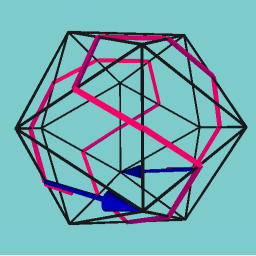 |
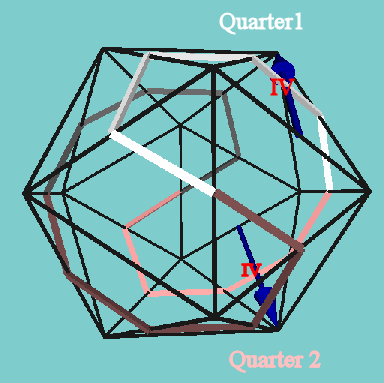 |
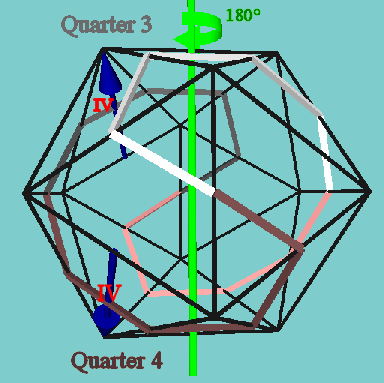 |
| +1 -> +0 TVS 1 | +1 -> +0 TVS 2 |
Click the button below the Winding_4 image on the left to see animation of Winding_4 rotating to the first TVS. The final orientation of Winding_4's Terminal Vectors match the pair of Face III Cross Vectors for Quarters 1 and 4 as shown in the middle image. They also match the pair of Face III Cross Vectors for Quarters 2 and 3 if spun 180° on the green axis shown in the far right image. Total TVS's: 2
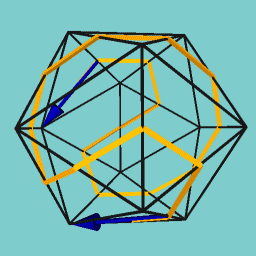 |
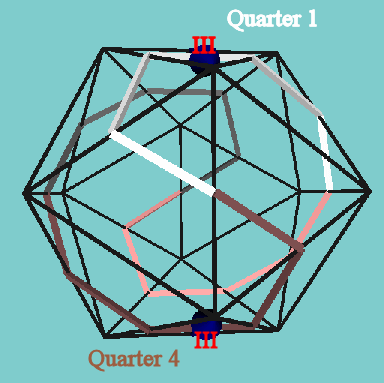 |
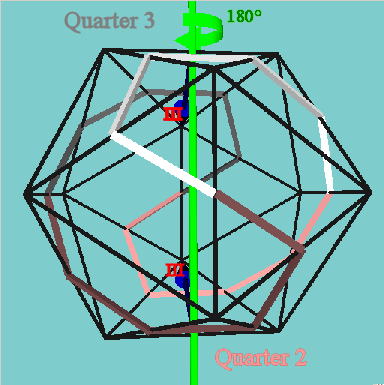 |
| +4 -> +0 TVS 1 | +4 -> +0 TVS 2 |
Click the button below the Winding_6 image on the left to see animation of Winding_6 rotating to the first TVS. The final orientation of Winding_6's Terminal Vectors match the pair of Face I Cross Vectors for Quarters 1 and 3 as shown in the middle image. They also match the pair of Face I Cross Vectors for Quarters 2 and 4 if spun 180° on the red axis and inverted as shown in the far right image. Total Fits: 2
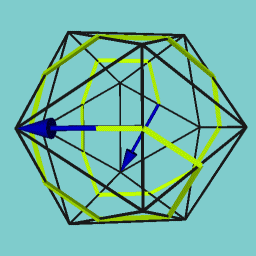 |
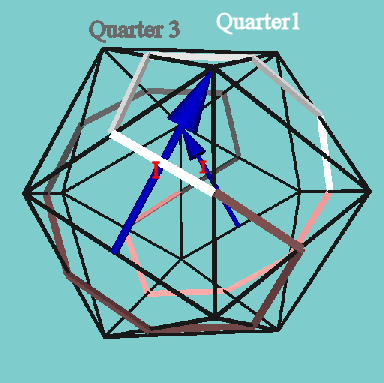 |
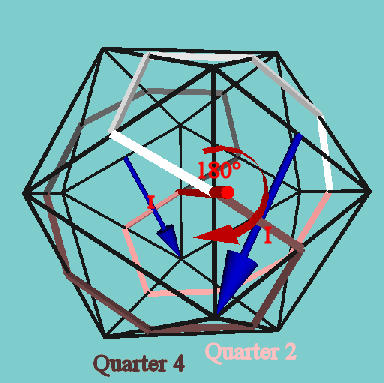 |
| +6 -> +0 TVS 1 | +6 -> +0 TVS 2 |
Click the button below the Winding_12 image on the left to see animation of Winding 12 rotating to the first TVS. The final orientation of Winding_12's Terminal Vectors match the pair of Face IV Cross Vectors for Quarters 1 and 3 as shown in the middle image. They also match the pair of Face IV Cross Vectors for Quarters 2 and 4 if spun 180° on the blue axis (simply inverted) as shown in the far right image. Total TVS's: 2
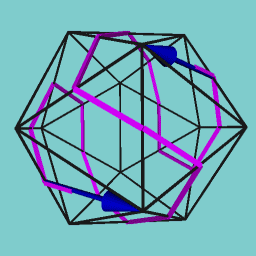 |
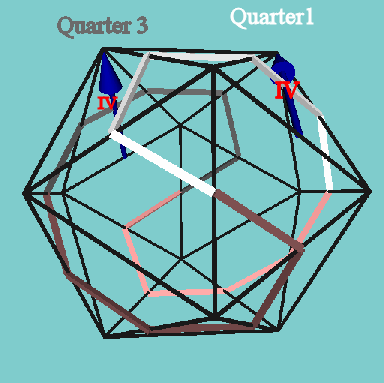 |
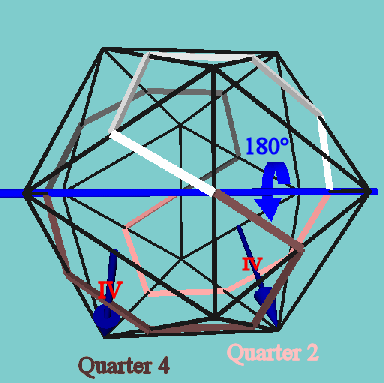 |
| +12 -> +0 TVS 1 | +12 -> +0 TVS 2 |
Click the button below the Winding_5 image on the left to see animation of Winding 5 rotating to the first State. The final orientation of Winding_5's Terminal Vectors match the pair of respective Face I and Face IV Cross Vectors for Quarters 1 and 3 as shown in the middle image. They also match the pair of respective Face I and Face IV Cross Vectors for Quarters 2 and 4 if spun 180° on the red axis and inverted as shown in the far right image.
TVS's: 1 and 2 of 4
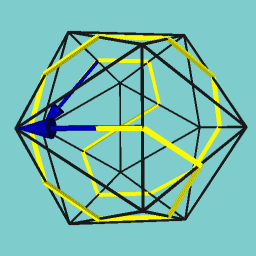 |
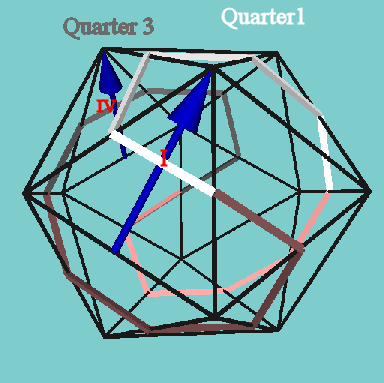 |
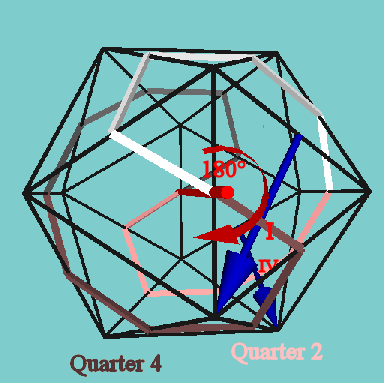 |
| +5 -> +0 TVS 1 | +5 -> +0 TVS 2 |
Because Winding_5 is asymmetrical it has a second Terminal Vector relationship with Quarter 1. Click the button below the second Winding_5 image on the left to view another animation of Winding_5 rotate for the third TVS. In this TVS the respective Face IV and Face I of Quarters 1 and 3 are used, so they are swapped when the middle image below is compared with the middle image of State 1 above. TVS 4 is achieved when TVS 3 is revolved 180° and inverted to use the Face IV and Face I respectively of Quarters 4 and 2 on the red axis as shown on the far right. TVS's: 3 and 4 of 4
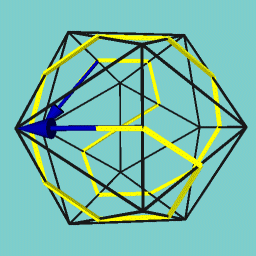 |
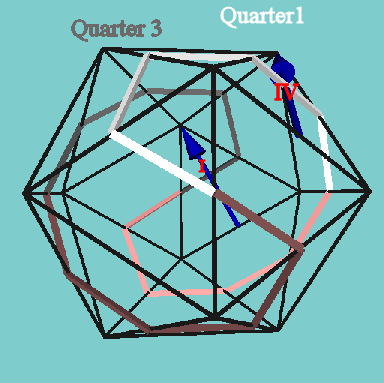 |
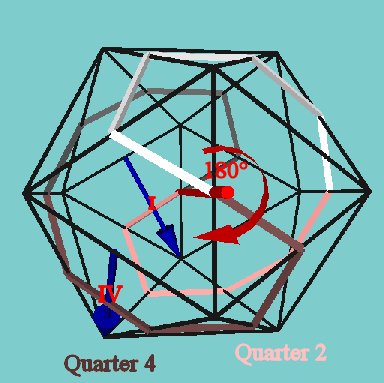 |
| +5 -> +0 TVS 3 | +5 -> +0 TVS 4 |
Next the TVS's of the remaining symmetrical Windings 8, 9 and 10 for Winding_0 will be explored. Each of these Windings has three basic TVS's in respect to Quarter 1.
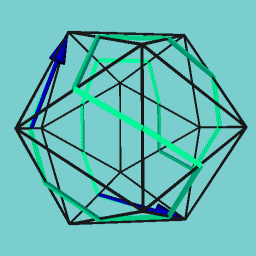 |
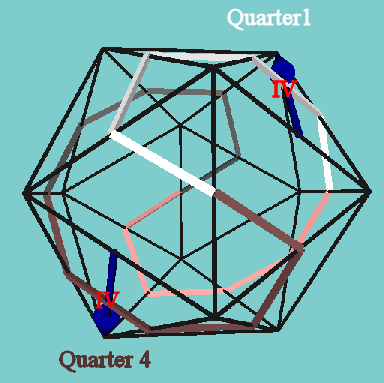 |
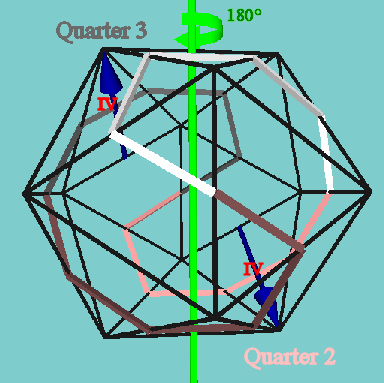 |
| +8 -> +0 TVS 1 | +8 -> +0 TVS 2 |
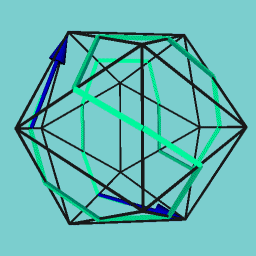 |
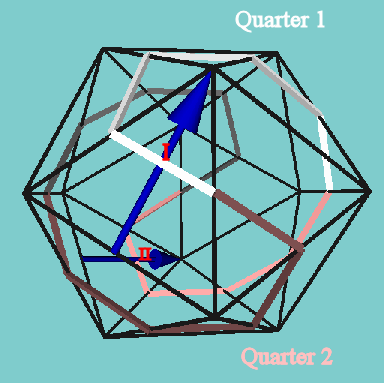 |
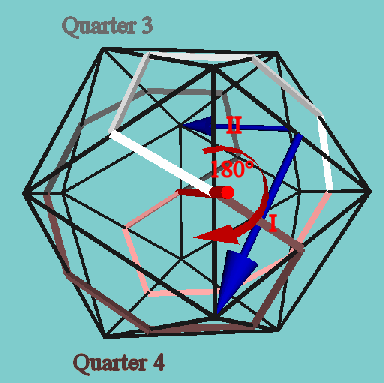 |
| +8 -> +0 TVS 3 | +8 -> +0 TVS 4 |
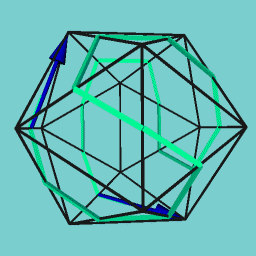 |
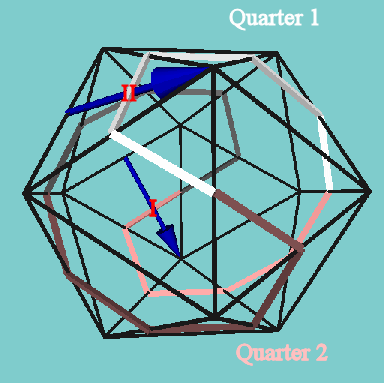 |
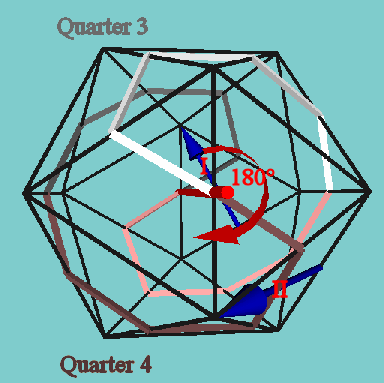 |
| +8-> +0 TVS 5 | +8 -> +0 TVS 6 |
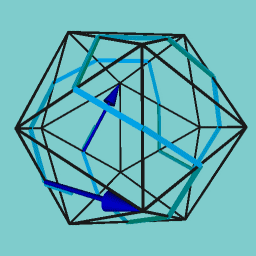 |
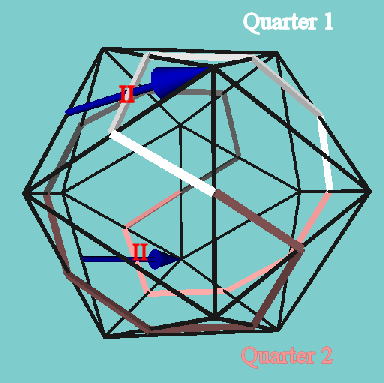 |
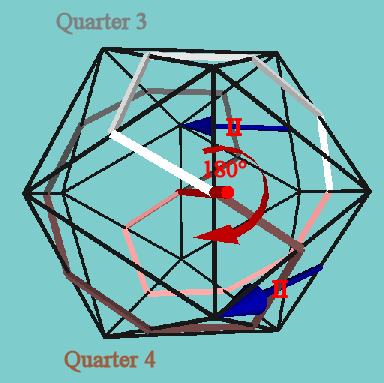 |
| +9 -> +0 TVS 1 | +9 -> +0 TVS 2 |
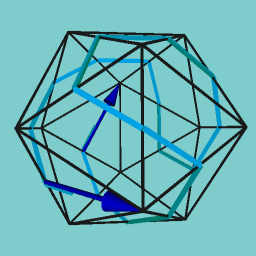 |
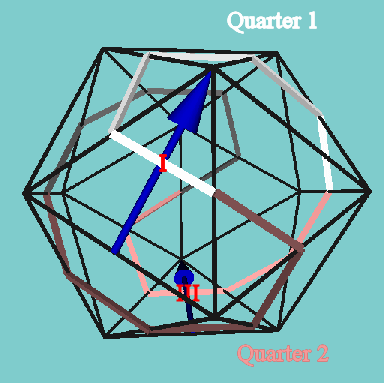 |
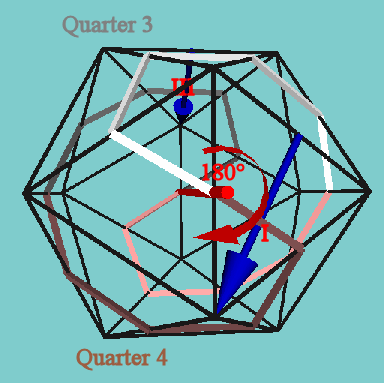 |
| +9 -> +0 TVS 3 | +9 -> +0 TVS 4 |
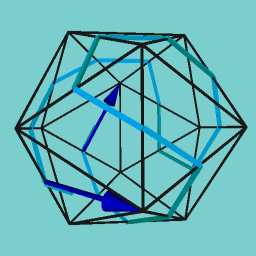 |
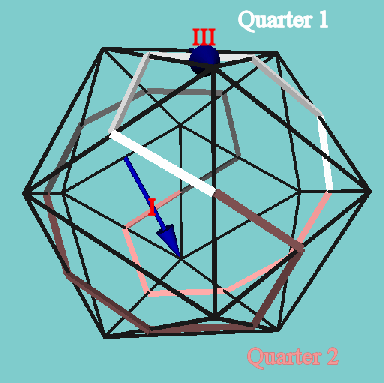 |
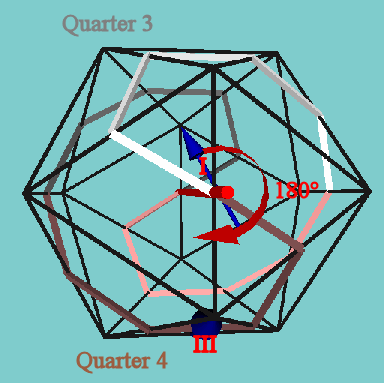 |
| +9 -> +0 TVS 5 | +9 -> +0 TVS 6 |
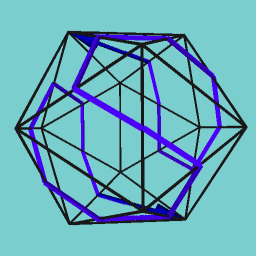 |
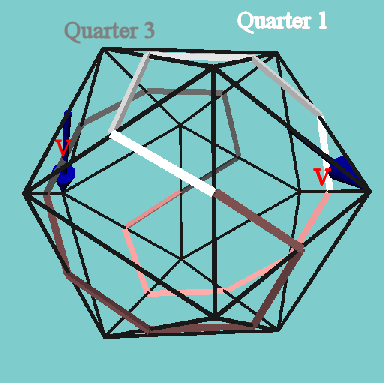 |
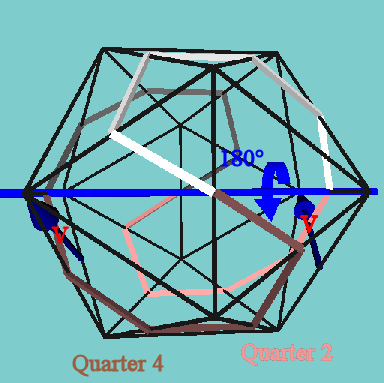 |
| +10 -> +0 TVS 1 | +10 -> +0 TVS 2 |
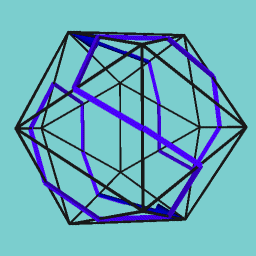 |
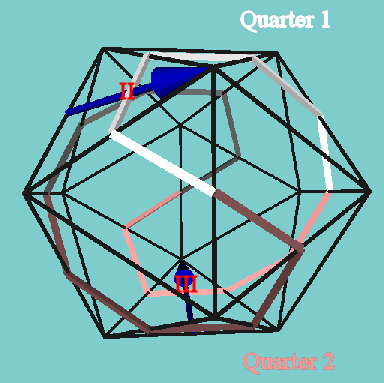 |
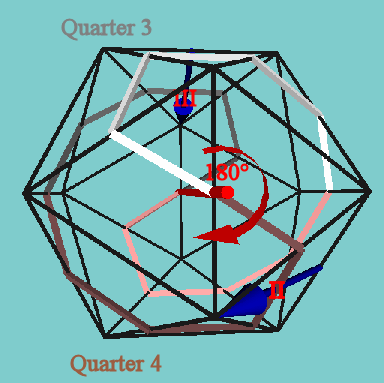 |
| +10 -> +0 TVS 3 | +10 -> +0 TVS 4 |
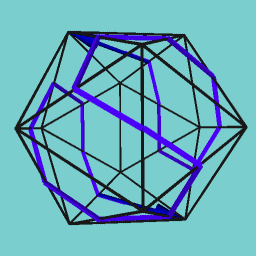 |
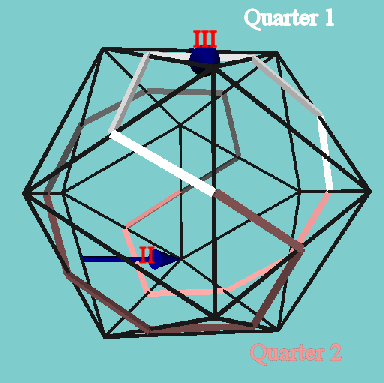 |
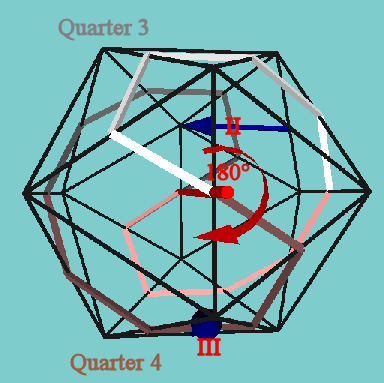 |
| +10 -> +0 TVS 5 | +10 -> +0 TVS 6 |
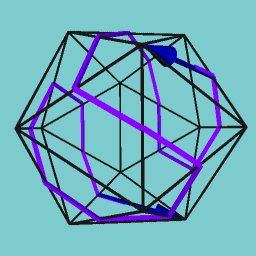 |
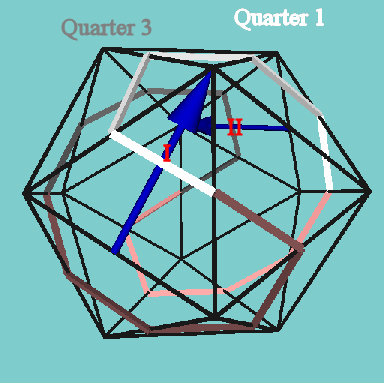 |
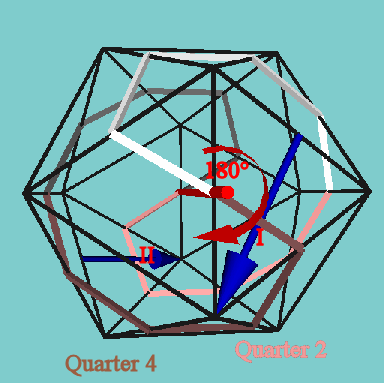 |
| +11 -> +0 TVS 1 | +11 -> +0 TVS 2 |
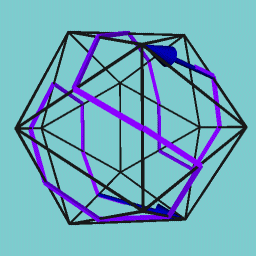 |
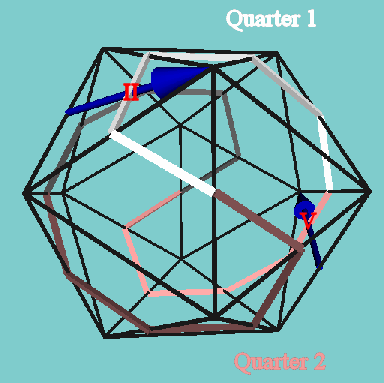 |
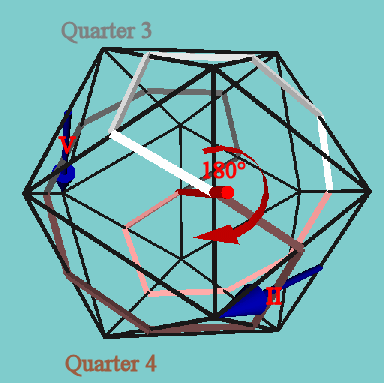 |
| +11 -> +0 TVS 3 | +11 -> +0 TVS 4 |
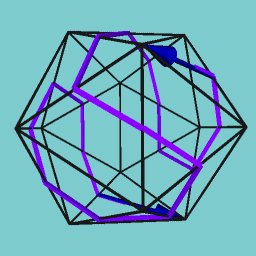 |
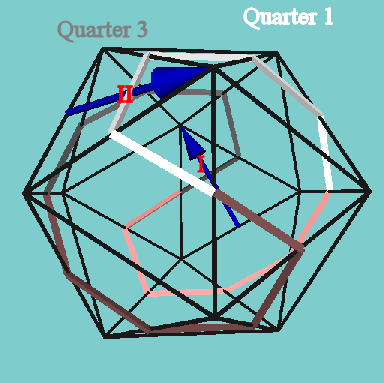 |
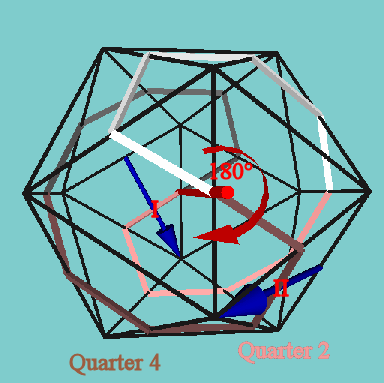 |
| +11 -> +0 TVS 5 | +11 -> +0 TVS 6 |
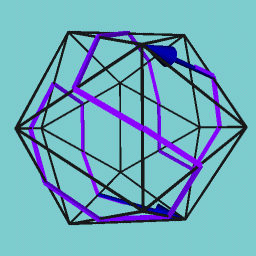 |
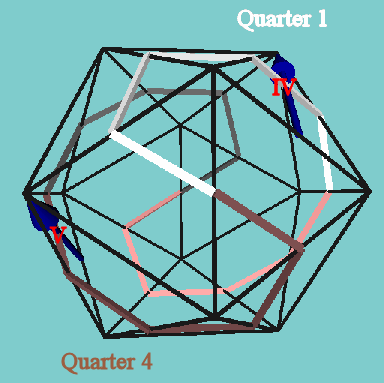 |
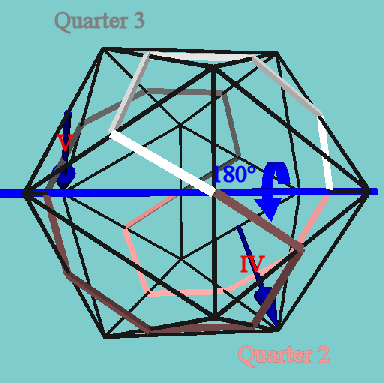 |
| +11 -> +0 TVS 7 | +11 -> +0 TVS 8 |
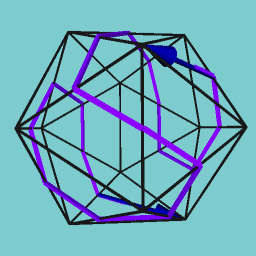 |
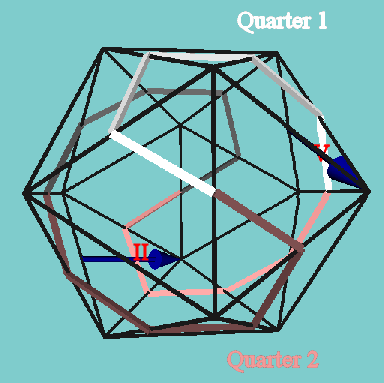 |
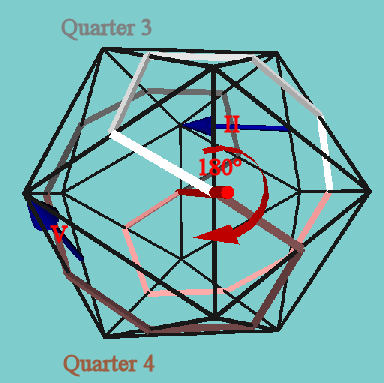 |
| +11 -> +0 TVS 9 | +11 -> +0 TVS 10 |
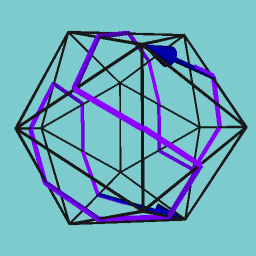 |
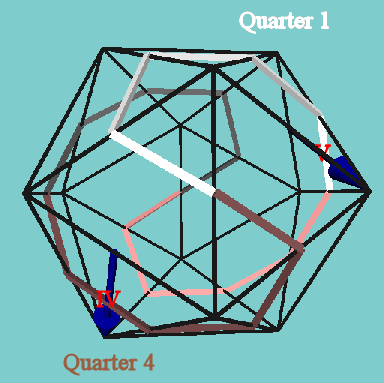 |
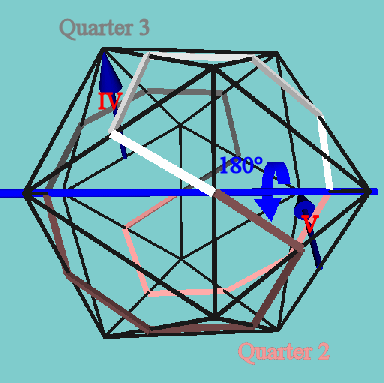 |
| +11 -> +0 TVS 11 | +11 -> +0 TVS 12 |
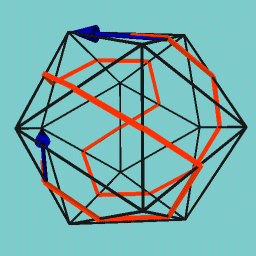 |
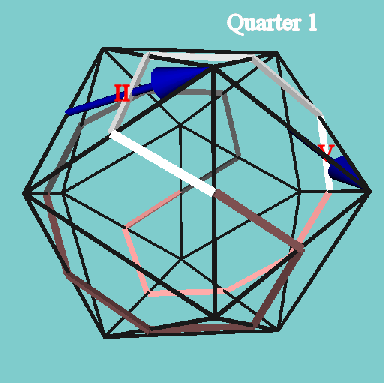 |
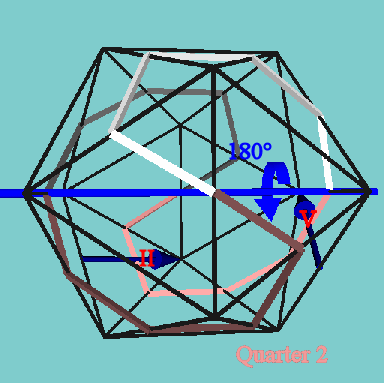 |
| +2 -> +0 TVS 1 | +2 -> +0 TVS 2 | |
 |
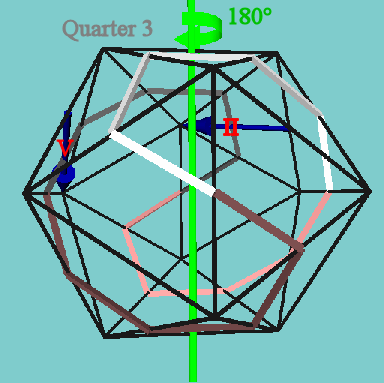 |
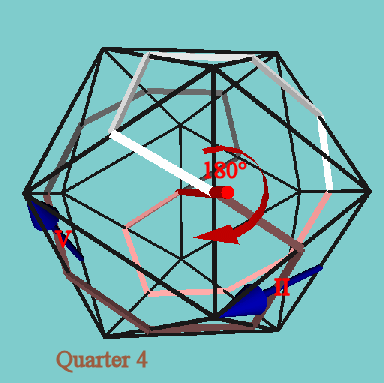 |
| +2 -> +0 TVS 4 | +2 -> +0 TVS 3 |
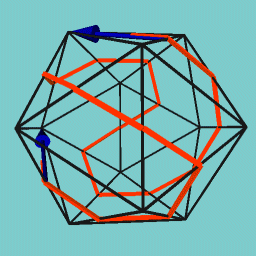 |
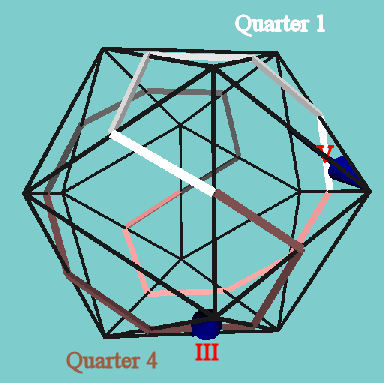 |
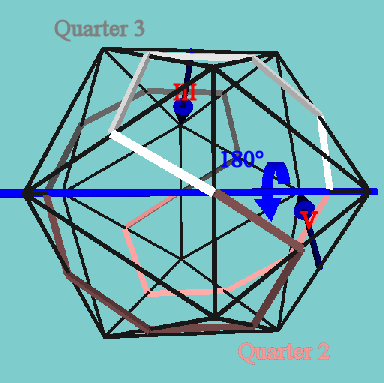 |
| +2 -> +0 TVS 5 | +2 -> +0 TVS 6 | |
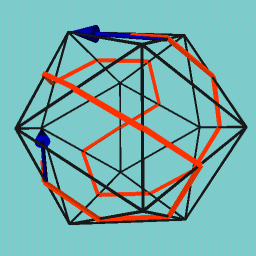 |
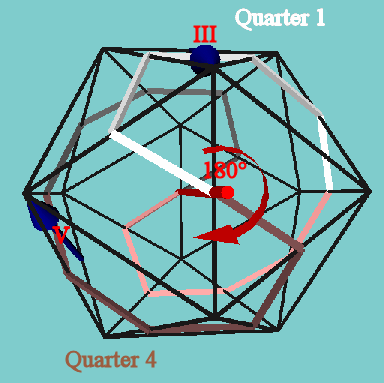 |
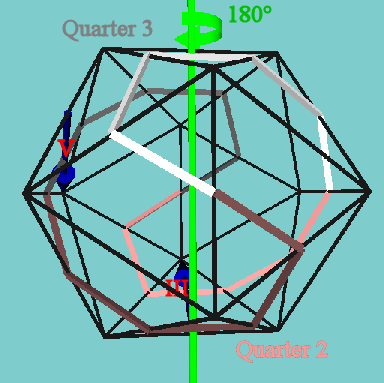 |
| +2 -> +0 TVS 8 | +2 -> +0 TVS 7 |
 |
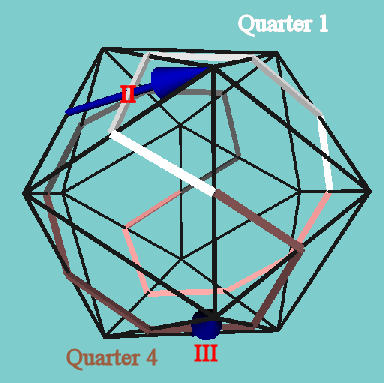 |
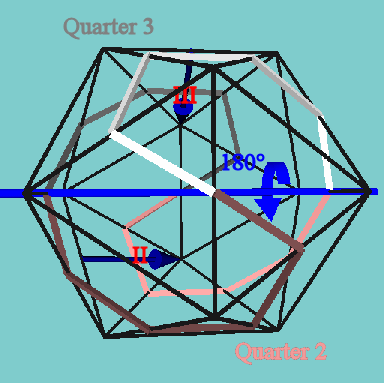 |
| +2 -> +0 TVS 9 | +2 -> +0 TVS 10 | |
 |
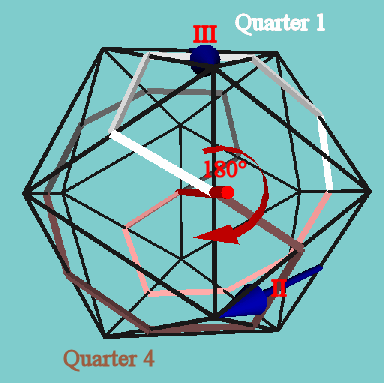 |
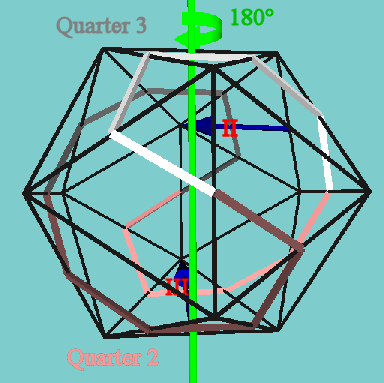 |
| +2 -> +0 TVS 12 | +2 -> +0 TVS 11 |
The animation below demonstrates the TVS's of Winding 2 in another way. During the animation notice how Winding 2 revolves around the white axis cylinder and how the revolution stops at TVS's 1, 5 and 9.
|
Winding_3 duplicates the TVS's of Winding_2; however, it is different construction in its own right.
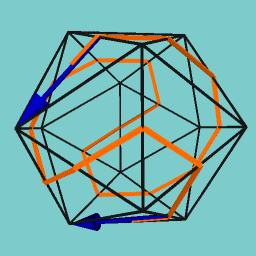 |
 |
 |
| +3 -> +0 TVS 1 | +3 -> +0 TVS 2 | |
 |
 |
 |
| +3 -> +0 TVS 4 | +3 -> +0 TVS 3 |
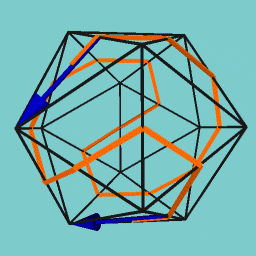 |
 |
 |
| +3 -> +0 TVS 5 | +3 -> +0 TVS 6 | |
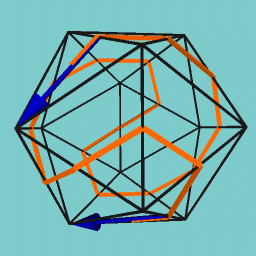 |
 |
 |
| +3 -> +0 TVS 8 | +3 -> +0 TVS 7 |
 |
 |
 |
| +3 -> +0 TVS 9 | +3 -> +0 TVS 10 | |
 |
 |
 |
| +3 -> +0 TVS 12 | +3 -> +0 TVS 11 |
+Winding_7
Winding 7 is the most complex, so its cataloging is divided into two parts.
Part 1:
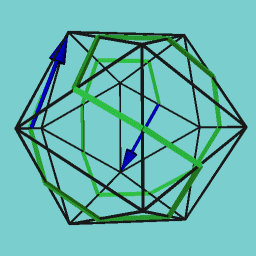 |
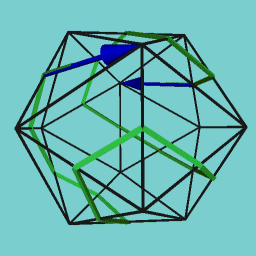 |
|
+7 -> +0 TVS 1
|
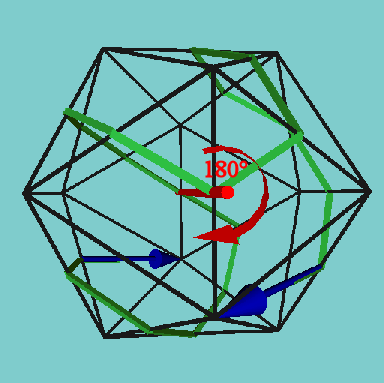 |
|
+7 -> +0 TVS 3 |
 |
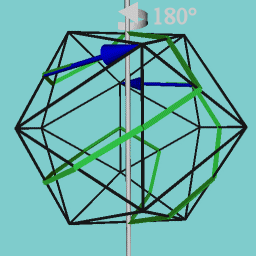 |
|
+7 -> +0 TVS 2
|
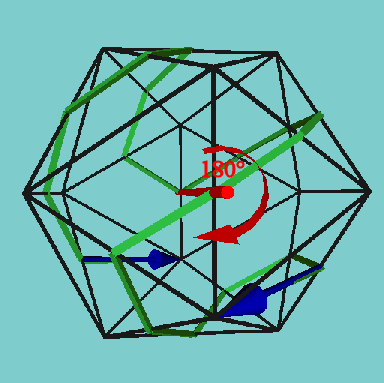 |
|
+7 -> +0 TVS 4 |
 |
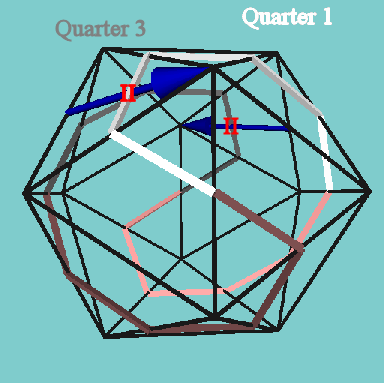 |
| TVS's 1 & 2 |
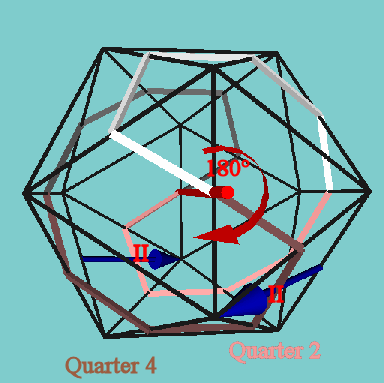 |
| TVS's 3 & 4 |
Part II:
 |
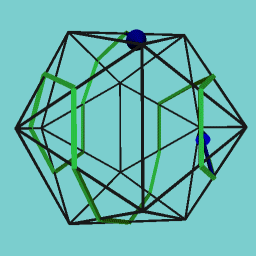 |
|
+7 -> +0 TVS 5
|
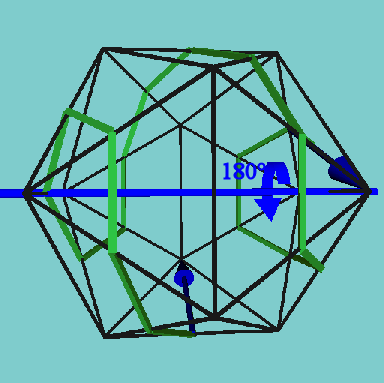 |
|
+7 -> +0 TVS 7
|
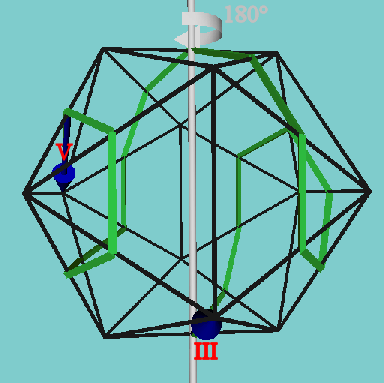 |
|
+7 -> +0 TVS 9
|
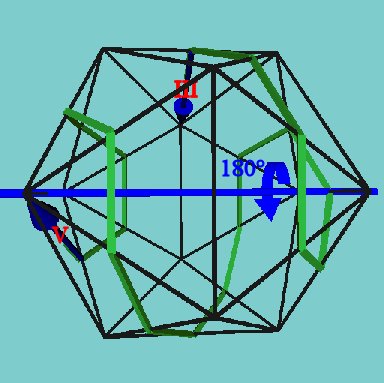 |
|
+7 -> +0 TVS 11 |
 |
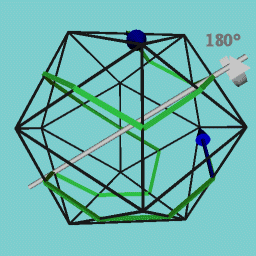 |
|
+7 -> +0 TVS 6
|
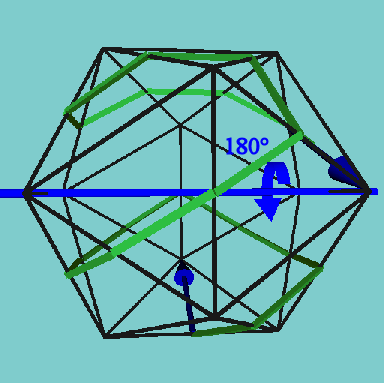 |
|
+7 -> +0 TVS 8
|
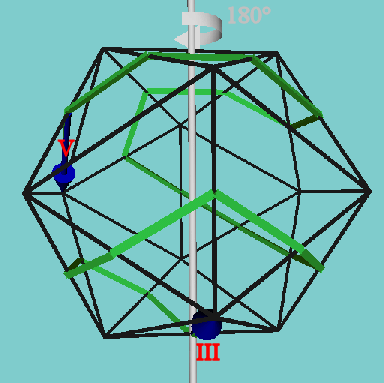 |
|
+7 -> +0 TVS 10
|
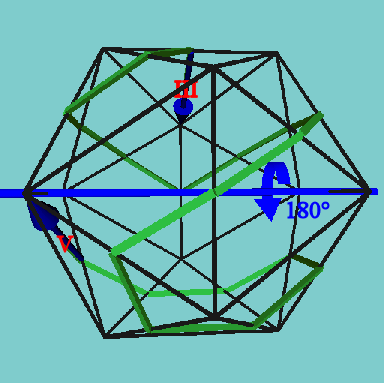 |
|
+7 -> +0 TVS 12 |
 |
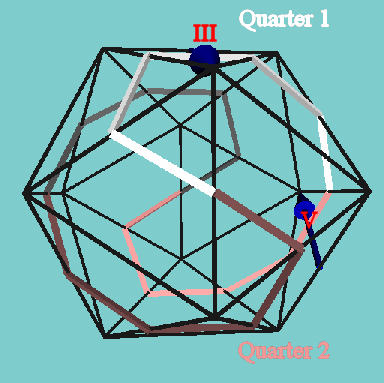 |
|
TVS's 5 & 6
|
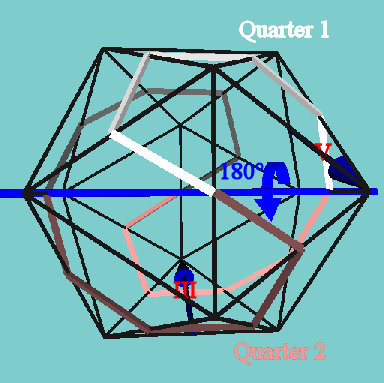 |
|
TVS's 7 & 8
|
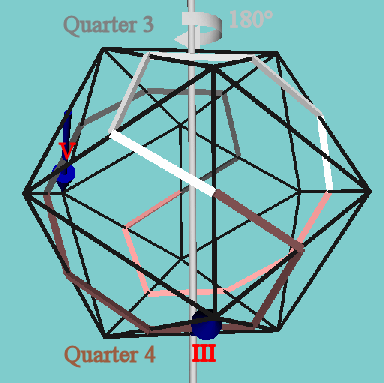 |
|
TVS's 9 & 10
|
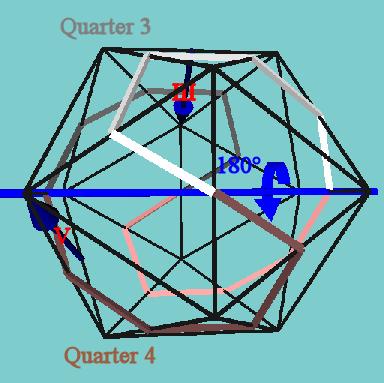 |
| TVS's 11 & 12 |
Now the total for the number of TVS's for +Windings 1 through 12:
| +Winding 1: | 2 |
| +Winding 4: | 2 |
| +Winding 6: | 2 |
| +Winding 12: | 2 |
| +Winding 5: | 4 |
| +Winding 8: | 6 |
| +Winding 9: | 6 |
| +Winding 10: | 6 |
| +Winding 2: | 12 |
| +Winding 3: | 12 |
| +Winding 7: | 12 |
| +Winding 11: | 12 |
| Total: | 78 |
The remarkable total of seventy-eight means that one traditional pack Tarot card can represent one TVS. It needs to be emphasized that the seventy-eight total was found by sheer accident through simply exploring the twelve Windings relationships to Winding_0. What isn't present is which card represent which TVS. A simple shuffled deck approach could be used that changes the card/TVS relationship with each shuffling. However, there is an even stranger numerical congruence between the Tarot and Terminal Vector States. This congruence lies deep in the original stated goal of recreating Winding_0's Cross Vectors with Terminal Vectors - the Terminal Vector State 0 Configuration:
|
|
|
Reiterating what was said at the beginning of the chapter, there are many ways to achieve a TVS 0 Config. shown in the above images with twelve TVS's. Now the reader has probably realized there is an excess present. That is, there are only twenty Faces of Winding_0 to mate with a total of twenty four Terminal Faces (two Terminal Faces per Winding) with their respective Terminal Vectors. Therefore, it is possible for two Windings to be dropped from the system and still have all twenty Winding_0 Faces covered. This allows a particular TVS 0 Config. to be designated by those dropped Winding(s) number suffix. Appendix C demonstrates two examples of TVS 0 Configs with different dropped windings.
With an ability to drop a Winding it would hypothetically be possible to develop a game where the dropped Winding could be transposed to another of its TVS's, thus enabling another Winding to be dropped and transposed, so that eventually all twelve Windings would go through a "drop and transpose" state. While all twelve Windings do have at least one TVS Config that drops them out, finding a connecting sequence of drop and transpose for all twelve proved futile after many hours of trial and error. While that is not to say it doesn't exist, another approach was tried by investigating the TVS relationship of the complementary twelve opposite -Windings to +Winding_0. Now things became very interesting and almost counter-intuitive, because it turned out that all twelve -Windings DO have a TVS relationship with +Winding_0!
TVS relationships of -Windings to +Winding_0 can be broken down into two groups. The first group will be termed the "Unique Group", because their TVS's are completely new and previously unused by the original +Windings. This group consists of -Windings 10, 11, 12 and 6:
-Winding_10:
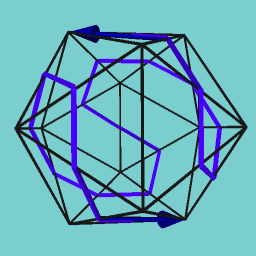 |
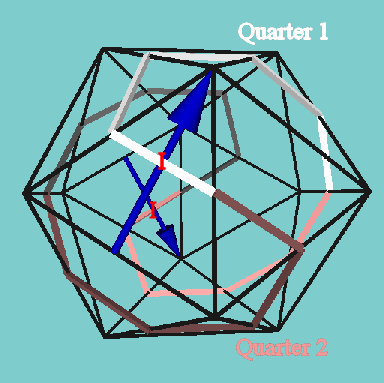 |
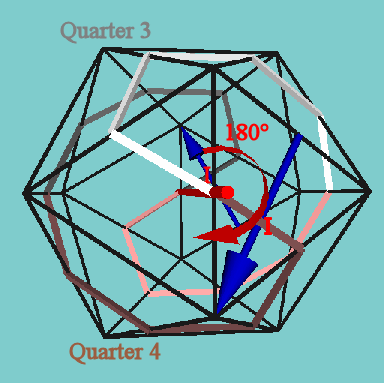 |
| -10 -> +0 TVS 1 | -10 -> +0 TVS 2 |
For comparison purposes the counterpart of +Winding_10 -> -Winding_0 for TVS 1 are shown below:
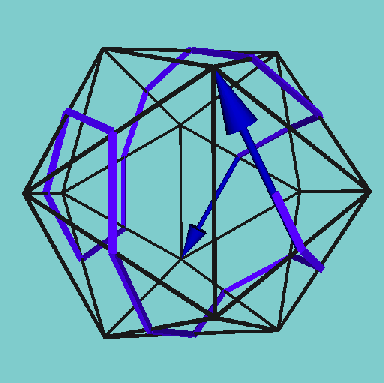 |
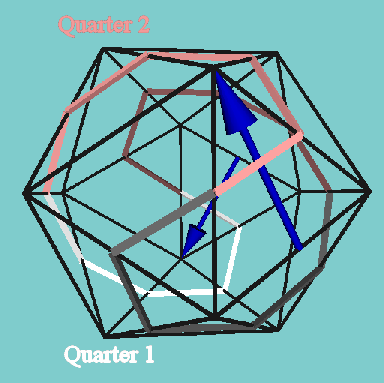 |
-Winding_11:
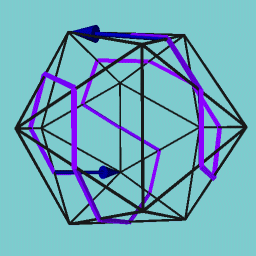 |
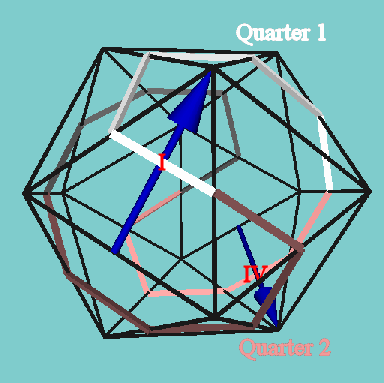 |
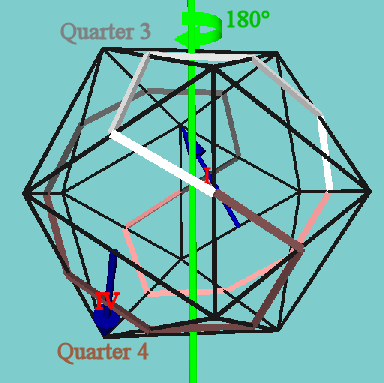 |
| -11 -> +0 TVS 1 | -11 -> +0 TVS 2 | |
 |
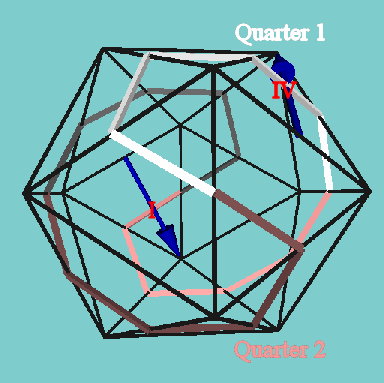 |
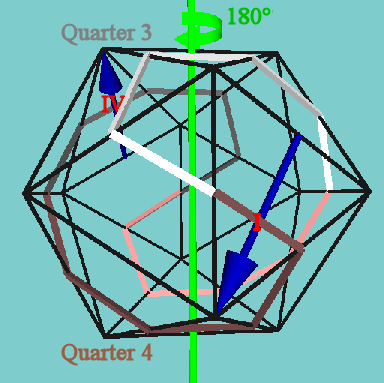 |
| -11 -> +0 TVS 3 | -11 -> +0 TVS 4 |
The counterpart images of +Winding_11 -> -Winding_0 for TVS 3 are shown below:
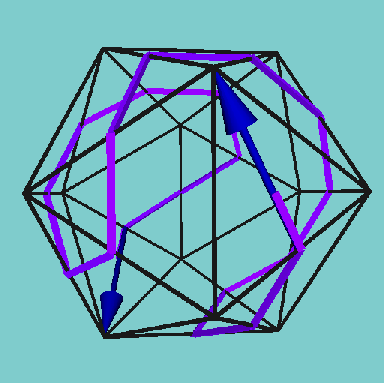 |
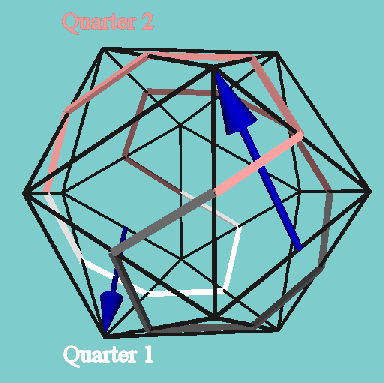 |
-Winding_12:
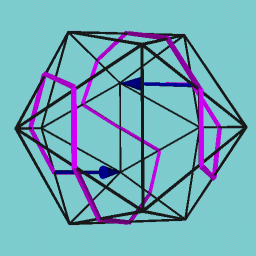 |
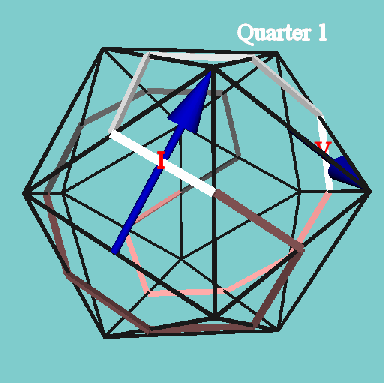 |
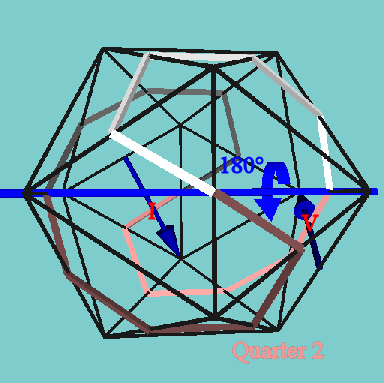 |
| -12 -> +0 TVS 1 | -12 -> +0 TVS 2 | |
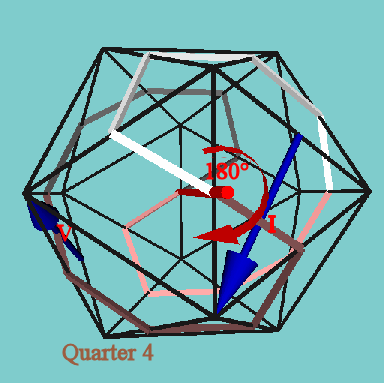 |
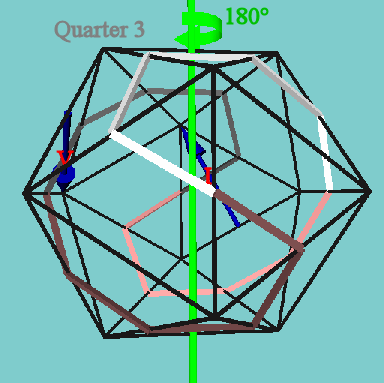 | |
| -12 -> +0 TVS 4 | -12 -> +0 TVS 3 |
The counterpart images of +Winding_12 -> -Winding_0 for TVS 3 are shown below:
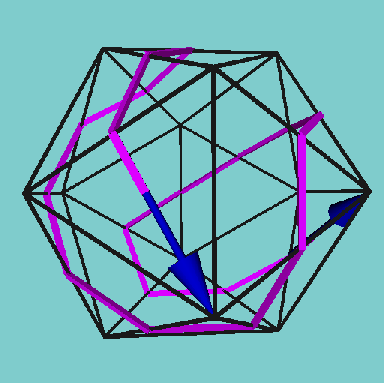 |
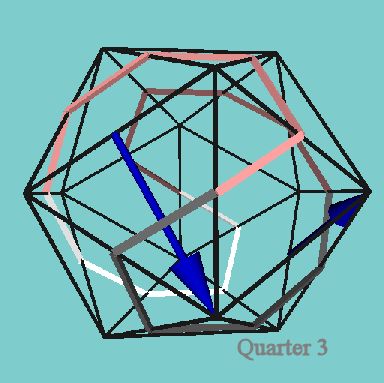 |
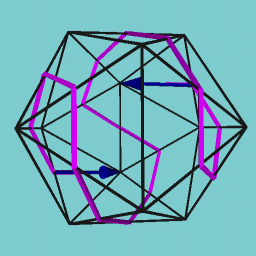 |
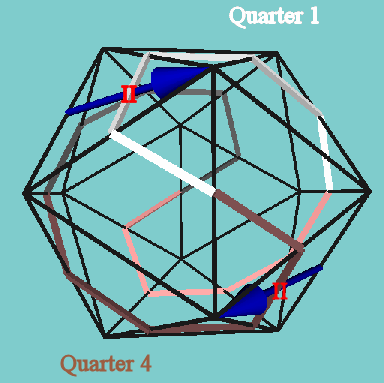 |
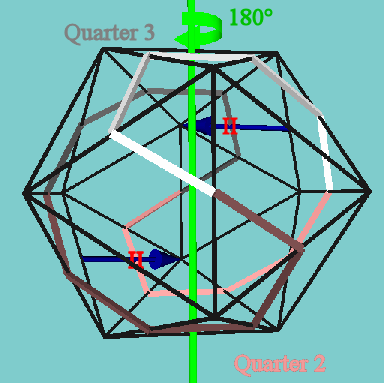 |
| -12 -> +0 TVS 5 | -12 -> +0 TVS 6 |
The counterpart images of +Winding_12 -> -Winding_0 for TVS 6 are shown below:
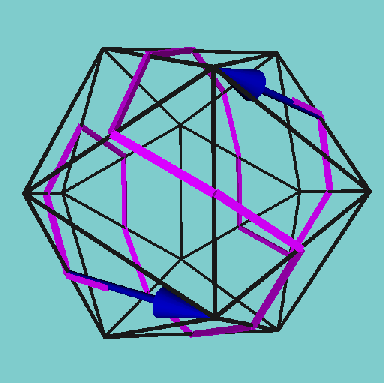 |
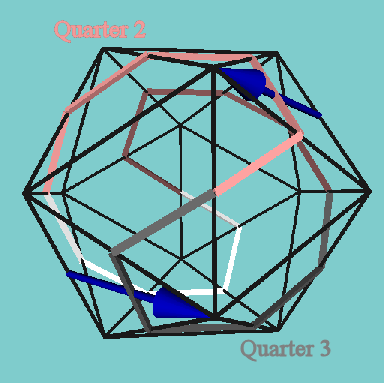 |
-Winding_6:
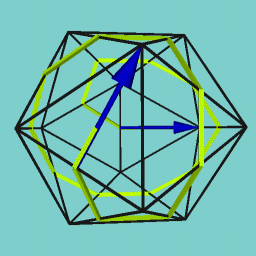 |
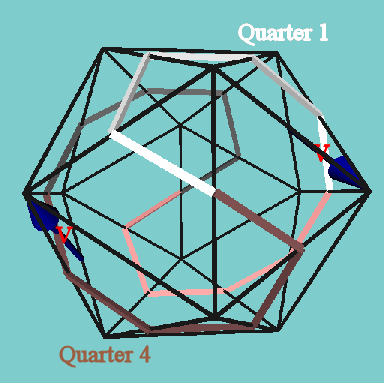 |
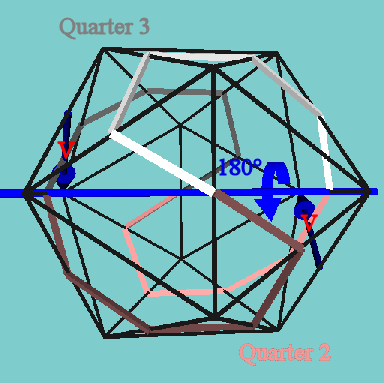 |
| -6 -> +0 TVS 1 | -6 -> +0 TVS 2 |
The counterpart images of +Winding_6 -> -Winding_0 for TVS 1 below:
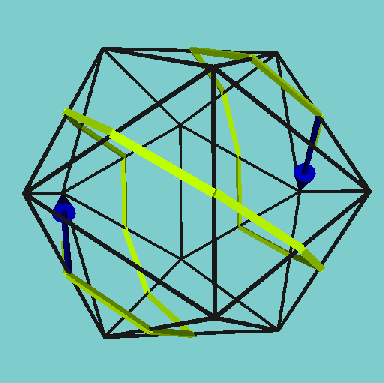 |
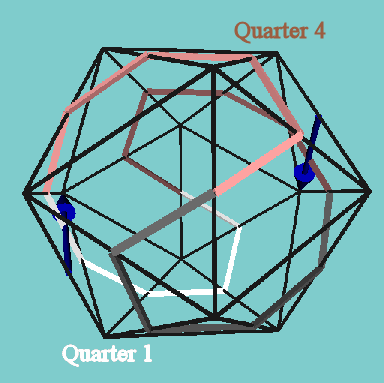 |
 |
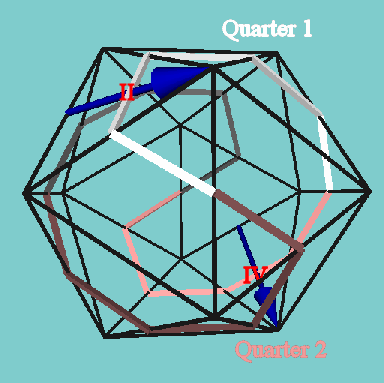 |
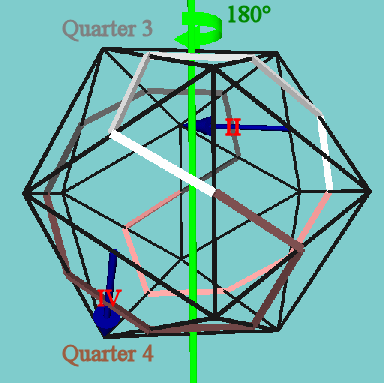 |
| -6 -> +0 TVS 3 | -6 -> +0 TVS 4 | |
 |
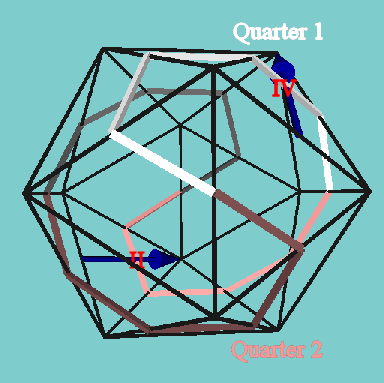 |
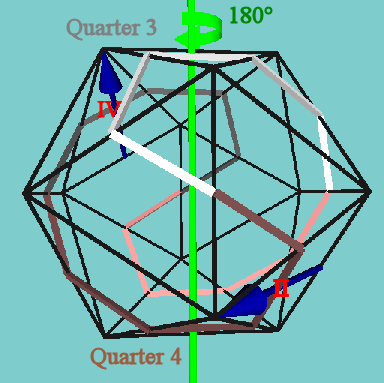 |
| -6 -> +0 TVS 5 | -6 -> +0 TVS 6 |
The counterpart images of +Winding_6 -> -Winding_0 for TVS 5 below:
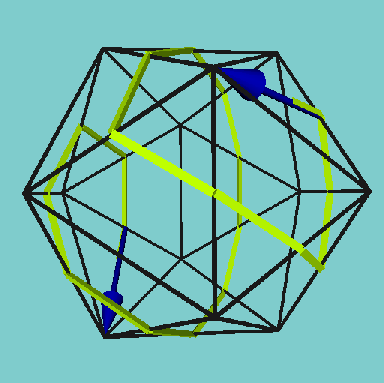 |
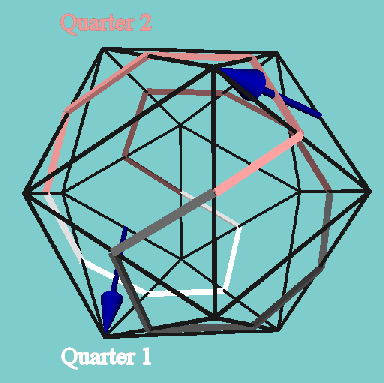 |
The four tier seven unit structure for the Reflective Group Windings below works similarly to the square and cube diagram on the upper right. Starting at the top is the simplest and most unitary. and while working downward gets more and more complex and diversified i.e. from the one to the multiplicity. Only one TVS in both + and - versions is shown for each tier to demonstrate the reflective symmetry of these + and - Windings.
The first tier is 1 or unity and is composed of just one TVS that is simultaneously BOTH the + and - TVS's. It uses just Winding_4s:
|
| |
|
-Winding_4 |
+Winding_4 |
Tier 2 below is composed of the + and - versions of both Winding_8 and Winding_9. +Winding_9 is itself just a variation on +Winding_8 that produces a mirror TVS. Since their structures are symmetrical and similar a sense of unity is maintained. Also, all four Windings share in the unity of having the same six total TVS's apiece. The TVS for -Winding_8 is the same as the TVS for +Winding_9 and the reflective TVS for +Winding_8 is the same for -Winding_9.
|
|
|
|
-Winding_8 |
+Winding_8 |
|
|
|
|
+Winding_9 |
-Winding_9 |
Tier 3 is composed of + and - versions of asymmetrical Winding_7 and symmetrical Winding_1. +Winding_1 and +Winding_7 have reflective TVS's. The asymmetrical Windings contrasted with the symmetrical ones breeds even more divergence from unity. Also the number of TVS's for the individual Windings vary depending on whether they reconstruct -Winding_0 or + Winding_0. +Winding_1 had only two TVS's in +_Winding_0. Since it has the same TVS's as -Winding_7, it has six TVS's to reconstruct -Winding_0. Likewise -Winding_7 acquires the two TVS's of +Winding_1 to reconstruct +Winding_0. However, it should be remembered that Winding_7 has a unique asymmetrical property that creates two different structures for each TVS, so it doubles the +Winding_0 TVS's to four:
|
|
|
|
-Winding_7 |
+Winding_7 |
|
|
|
|
+Winding_1 |
-Winding_1 |
Tier 4 is composed entirely of the asymmetrical + and - versions of Winding_2, Winding_3 and Winding_5. +Winding_5 has the same TVS's as -Windings_2 and _3 and visa-versa. Consequently +Winding_5 now has twelve TVS's, while -Winding_2 and -Winding_3 now only have four in the context of rebuilding -Winding_0. The increase in the total number of Windings along with the variations in TVS's brings even more divergence from unity.
|
|
|
|
-Winding_2 |
+Winding_2 |
|
|
|
|
+Winding_5 |
-Winding_5 |
|
|
|
|
-Winding_3 |
+Winding_3 |
The end result is that Windings 1 through 12 of one polarity can reconstruct a Winding_0 of the opposite polarity and create its Terminal Vector State 0 Configuration. Hence the search for a single path linking one drop and transpose Winding to another became moot, because empty Cross Vectors of Winding_0 are now easily filled by using a Winding of opposite handedness. In other words, ANY path would now work and any Winding could easily be dropped out! A Terminal Vector State 0 Configuration for +Winding_0 using only negative Windings is demonstrated in Appendix C Example 3.
A Strange Congruence
A further strange and uncanny congruence now showed up between the Terminal Vector States and the Tarot because the Windings of the Unique Group do distinguish themselves from the Reflective Group Windings. The Unique Group in their original TVS relationship to the Winding_0 of the same handedness has a total of twenty-two TVS's -the same number of cards as the Tarot deck Major Arcana:
|
Unique Group +Windings |
TVS's |
|
Symmetrical |
|
|
2 | |
|
6 | |
|
2 | |
|
Subtotal: |
10 |
|
Asymmetrical |
|
|
12 | |
|
Total: |
22 |
The remaining Reflective Group Windings in their original TVS relationship to Winding_0 of the same handedness elegantly breakdown into sixteen TVS's for the symmetrical Windings and forty TVS's for the asymmetrical. Those are the number of cards for the Tarot court cards and small cards respectively:
|
Reflective Group |
|
For the TVS totals of -Windings in relation to +Winding_0 please see Appendix D!
It needs to be emphasized that these new congruences were not found until a twelve Windings set of one polarity was applied to the Winding_0 of opposite polarity to find possible new Terminal Vector States. This find brings a dovetailing here of Chapter 1 and its subject on how the taijitu/yin-yang symbolism can be geometrically found in the icosahedron and dodecahedron.
While there is now a further break-down attribution of sections of the Tarot deck to seventy-eight Terminal Vector States, there is not an immediate and specific card to TVS correspondence. This will be described in detail an upcoming chapters; however, a brief outline of how it can be accomplished will be given here. The underlying principal for accomplishing the correspondence is to generate sigils (that is glyphs) from the geometry of the relevant TVS's and then compare and separate these sigils by appearance and dynamics into groups of four and three. It is same concept used in the sigil system developed at the end of Chapter 2 that will tie the cards to geometry as sinews tie flesh to bone.
1. Starting with the twenty-two Major Arcana cards and the Unique Group of TVS's it can be seen from the Unique Group table above that symmetry vis'a vis asymmetry plays a part in the attribution specifics. The asymmetrical +Winding_11 has twelve TVS's so its TVS's will be the Major Arcana signs representing the twelve zodiac signs. The ascribing of which zodiac sign to which to TVS can be done by creating sigils from each of the twelve TVS's and breaking that down to families of four elements fire, earth, air and water. Each of these element families contains three children as the three principals active, neutral, and passive (aka sulphur, mercury, and salt) that translated in astrological terms are known as cardinal, cherub and common signs respectively.
The three remaining symmetrical +Windings 6, 10 and 12 TVS's will be elaborated on in the next chapter as seven planets/metals and three principals attributions.
2. The court cards to TVS attribution will be determined by creating sigils for each of the sixteen TVS's that belong to the Reflective Group's symmetrical Windings. These sigils too are based on four element/suit families, but containing four sub-elements instead of principals.
3. The forty small cards attribution for the remaining TVS's of the Reflective Group's asymmetrical Windings creates a more complex situation. +Winding_5 will have only four element sigils, while +Windings 2, 3, and 7 will have sigils created for their respective twelve TVS's based again on four element families with three principal children similar to what was done for +Winding_11 above. Those sigils for +Windings 2, 3, and 7 will represent groups of three sequential integers (i.e. 1 (ace), 2 and 3) and their four element/suits each. For example the twelve +Winding_2 sigils could represent:
|
1. Ace of wands (fire), ace of cups (water), ace of swords (air), and ace of coins (earth) |
|
2. Two of wands, two of cups, two of swords, and two of coins |
|
3. Three of wands, three of cups, three of swords and three of coins |
The ace, two and three would be assigned the sulphur, mercury, and salt principals as their respective astrological terms of cardinal, cherub, and common give a natural progression of descent. The cycle would start over with the next +Winding using next three integers of 4, 5 , and 6. +Winding_5 with only four TVS's creates an odd-man out situation. However, there is a natural geometric progression of these four asymmetrical Windings that has +Winding_5 always directly preceding +Winding_7 sequentially, so if +Winding_7 represents the twelve cards of 8, 9, and 10 +Winding_5 sigils will be the four 7 cards just before it.
Before going on, there seems to be a need for "a likely story" (as Socrates dubbed his creation myth in the Timaeus) as to the WHY of this strange congruence because a long-shot piece of luck explanation seems inadequate. Any half-baked notions centered around "Secret Chiefs" or the like will be forgoed for the fully raw concept of Tarot as revelation to man's consciousness from the ancient idea of Logos -the cosmos creating command or execution of the Absolute. Since the Greek word "Logos" has alternately been translated as "word" or "light", then (using a technological analogy) given that the internet is now largely driven by fiber-optic technology (i.e. light as information) there is no reason why "word" and "light" can not be read as just two sides of one spiritual coin. This likely story though will focus on the light side of the coin and the working analogy for the story will be the ability that the light (of our material cosmos) has to create a rainbow or color spectrum through refraction.
Quoting but condensing several articles from Wikipedia: "A rainbow is an optical and meteorological phenomenon that is caused by both reflection and of light in water droplets in Earth's atmosphere, resulting in a spectrum of light appearing in the sky". Refraction itself is defined in Wikipedia as: "the change in direction of a wave due to a change in its transmission medium." So in regard to rainbow creation, a light wave traveling in the medium of air suddenly enters the new medium of the water droplet and is bent. The bending of the light causes the different vibration rates of red and blue light to be separated. The red and blue light reflect against the back the water droplet and on exiting back into the medium of air are bent and broken up yet again to separate further the colors of the spectrum.
Applying the refraction concept to the Windings:
1. TVS's are a representation of the Windings' individual properties as vibration rate is a property of different wave lengths of the light spectrum.
2. The seventy-eight constituent TVS's of the "transmission medium" of one handedness are bent and split on entering the "different transmission medium" of the opposite handedness into two groups of twenty-two and fifty-six based on their respective Unique and Reflective Group properties. The twenty-two and fifty-six are refracted again through a second divergence of transmission mediums involving symmetry/asymmetry into "colors" of (10 + 12) for the former and and (16 + 40) for the latter.
This refraction analogy is really being applied to the Logos because Logos IS the Windings in a guise of Mathematical information. As an execution of the Absolute, Logos is both the conveyor of that information and the information itself. Now if Logos is both sets of + and - Windings and either collection can be refracted in the other to break up its 78 constituents into two distinctive information beams of 22 and 56, then Logos can be said to refract itself.
However, when it comes to the actual Tarot cards and their images that share the congruence, another transmission medium for refraction comes into play, but several "givens" must be stipulated in order to continue building on this likely refracting story.
(Quotes from ancient and other sources can be found by following the provided links and using the "Find" feature in your browser.)
1. The Platonic idea that the dodecahedron is an image of the universe in geometric form. In addition to the quotes from Plato's dialogues "handedness and "Phaedo"s stated in Chapter 1: There is also later on in antiquity a more succinct statement of the dodecahedron as universe in a writing attributed to Timaeus of Locri of Plato's dialogue: "But the deity made the dodecahedron the image of the Universe, as being the nearest to the sphere." (Material excerpted from the book Pythagorean Source Book 1987, 1988 by Phanes Press with permission from Red Wheel/Weiser, LLC Newburyport, MA and San Francisco, CA www.redwheelweiser.com )
2. The Hermetic maxim: "As above so below" from the famous Emerald Tablet: http://www.sacred-texts.com/alc/emerald.htm and its corollary that Man is a microcosmos, that is a miniature reflection of the macrocosmos and in turn the macrocosmos mirrors man as Anthropos the Cosmic Man: http://en.wikipedia.org/wiki/Adam_Kadmon
|
|
The header image is reiterated below as an amalgamation of esoteric images expressing the self-refracting Logos origin of the Tarot as a collective projection of Anthropos.
It starts with the Robert Fludd engraving "Vitruvia Macrocosm" which shows man pentagonally outstretched and superimposed on the cosmos as Anthropos. Vitruvia Macrocosm is merged into a dodecahedron so that the image accentuates and amplifies the merger of man and cosmos. In turn, that image has been integrated into the taijitu as symbol of integrated opposites. The images from an early Marseilles deck are produced by Man's experience in matter by the continually self-refracting Logos symbolized by the emerald lines. Of course, while the self-refracting Logos approach can be applied to anything in the cosmos, the strange congruence demonstrated here just makes the story more likely.
|
|
Dissolve and Coagulate Relationship with Chapter 2
Previously, Chapter 2 aligned the twelve Windings with the twelve vertexes/faces using what was described as short-hand versions of the Windings using edges of the icosahedron and labeled with an acronym prefix of "ISH". Which vertexes these individual ISH Windings ended at created those alignments. Some of these ISH terminations pointed to the same vertexes as the Terminal Vectors (Terminal Vertexes) and some did not. In this chapter, Terminal Vertexes -those pointed to by Terminal Vectors- were used exclusively. So there are two different vector systems currently at work within this system as a whole. An analogy between these vector systems to the tuning systems of music theory is appropriate here, that is the way a musical instrument can be tuned to create the intervals within an octave. No musical tuning system is perfect. Each has its uses and benefits as well as its limitations. For example, the ancient tuning system termed the "Pythagorean" which tunes twelve individual strings by perfect fifth intervals does not produce a note at the thirteenth step that is exactly a multiple of twice the vibrations of the original starting note. This "thirteenth step" is a little higher in pitch (vibration rate per second) and this difference with a pure octave is called by music theorists a "Pythagorean comma". Other tuning systems will sacrifice the perfect fifths for a scale that does end as a pure octave. In this analogy, each of the vector systems "re-tunes" the Windings to a different vertex to achieve the different end results of dissolving and coagulating:
1. Dissolve: ISH_Winding system of Chapter 2 broke Winding_0 apart into twelve different Windings.
2. Coagulate: Terminal Vector State system of this chapter reconstructed Winding_0 back together again.
This "tuning" analogy underlies the theory of this entire philosophical machine and will be used continually throughout the rest of this work.
Summary and Implications of Chapter 3
Because of the strange congruence between a Tarot deck and the TVS permutations it is possible for a TVS to represent a single Tarot card. Now the word "State" in "Terminal Vector State" implies the ability to change -that is from one state to another and one card to another. Complementing this potential for change is the term "constant" -that which does not change and this will be the static geometry. This "TVS card " can refer and point back to static geometry using its Terminal Vectors and/or even Cross Vectors. These "pointed-to" static geometry shapes can be used in many different ways. They can be interpreted variously as the four elements, three principals and seven metals/planets through sigils -that is glyphs or short-hand images of their structure, and thus form the foundation for new cards. Moreover this malleable pointing ability of a TVS could also pick out previous events of the system if those events are associated with the pointed-to vertex. There are probably even more new capabilities of this chapter's newly found strange congruence waiting to be found.
Finally, Appendix B of this chapter shows how a particular small card can pick out a new Winding_0 which in turn reveals twelve new Windings 1 through 12 (refer to Chapter 2) so the system will come full circle (i.e. refresh or reboot) and continue.
Up coming Chapter 4 "Seven Syzygies and the Music of the Spheres" will take a break from the Windings and focus on the inherent seven-ness of the icosahedron/dodecahedron and how this geometric seven-ness can be found through the application of the twelve-tone music scale.
An interesting facet of the symmetrical Windings of the Unique Group is demonstrated here. Their total twenty Terminal Vectors complete a Winding_0 without duplication:
|
|
|
|
|
+Winding_6 TVS 1 |
+6 -> +0 TVS 1 |
+6 -> +0 TVS 2 |
|
|
||
|
+Winding_6 TVS's 1 and 2 |
||
|
|
|
|
|
+Winding_12 |
+12 -> +0 TVS 1 |
+12 -> +0 TVS 2 |
|
|
||
|
+Winding_12 reiterated with +Winding_6 TVS's |
||
|
|
|
|
|
+Winding_10 |
+10 -> +0 TVS 1 |
+10 -> +0 TVS 2 |
|
|
||
|
+Winding_10 TVS's 1 &2 Combined with +Winding_6 and +Winding_12 TVS's |
The four remaining TVS's 3, 4, 5 and 6 for +Winding_10 are shown below using an alternate rotation method than the ones previously shown above. TVS's 4, 5, and 6 are obtained by rotating TVS 3 on the three mutually perpendicular red, green and blue axis respectively.
|
|
|
|
|
+Winding_10 TVS 3 |
+10 -> +0 TVS 3 |
+10 -> +0 TVS 4 |
|
|
|
|
|
+10 -> +0 TVS 6 |
+10 -> +0 TVS 5 |
+10 TVS's 3, 4, 5, and 6 |
|
|
|
|
|
+Winding_10 TVS's 3, 4, 5, and 6 Combined with +Winding_6 and +Winding_12 TVS's |
All Twenty Terminal Vectors Combined to Construct +Winding_0 |
+Winding 10 TVS's 1, 2, 3, 4, 5, and 6 |
This appendix demonstrates how a small card (ace to 10) can pick a new Winding_0 from out of ten possible Winding_0s that share the same Face Vector on one Quarter of a Winding_0. This mechanism will termed as "New Winding_0 Selection Process". While the working theory behind this new mechanism will be shown, all the sigils and charts shown below are only tentative and most likely will be expanded upon; therefore, only +Winding_0 will be demonstrated as the conversion for -Winding_0 sigils and charts is trivial.
Before continuing though, the total number of possible Winding_0s that an icosahedron contains has to be established. The opposite edges connecting the small inner half circles will be used to represent each Winding_0. Edges in this context will be termed "Centering Edges" with the acronym "CE"(shown below in red):
|
|
|
Centering Edges Inner Half Circles |
and since there are thirty edges to an icosahedron, then there are exactly fifteen of Winding_0s needed to use all opposite edges of an icosahedron. Of course when the opposite handedness is taken into account the total doubles to thirty, but at the moment the focus is only on Winding_0s of the same handedness.
These fifteen pairs of Centering Edges need to be organized and labeled. This will be done using the colors red, blue and green for front/back, left/right and top/bottom respectively with numerical labeling 1 through 5. These labeled and colored edges will be termed as the "Reference Frame". Notice how opposite edges have the same number:
|
|
|
|
|
Centered Edges Front and Back |
Centered Edges Left and Right |
Centered Edges Top and Bottom |
A nomenclature for the Windings will consist of R, B, or G for the color and the number of the Centered Edge. "R_5" will be the contextual designation for the original +Winding_0 to which the specific Quarter 1 belongs:
|
|
|
R_5 +Winding_0 |
|
|
|
|
|
R_5 +Winding_0 into Four Quarters |
Quarter 1 with Cross Vectors |
Five Cross Vectors |
The particular position of R_5 +Winding_0 and its Quarter 1 Cross Vectors shown above will be termed Master Quarter Orientation and the reference for any Quarter that has been selected/picked for this New Winding_0 Selection Process. In order to minimize the number of charts and sigils needed, the Centered Edge color coding system shown above is kept relative to Quarter 1 belonging to R_5 +Winding_0. In other words a particular Quarter 1 is rotated to the Master Quarter Orientation as the animation below left rotates the light blue Quarter to match the to match the middle image. The animation on the right demonstrates what is actually being done, because in reality it is not the particular Quarter and its Winding_0 that is rotated but the Reference Frame. Notice how the labeling has been rotated as well. This is really just a simple matter of swapping viewpoints for convenience.
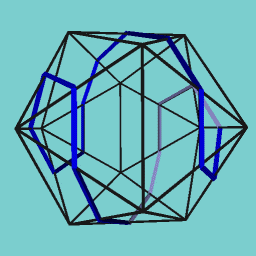 |
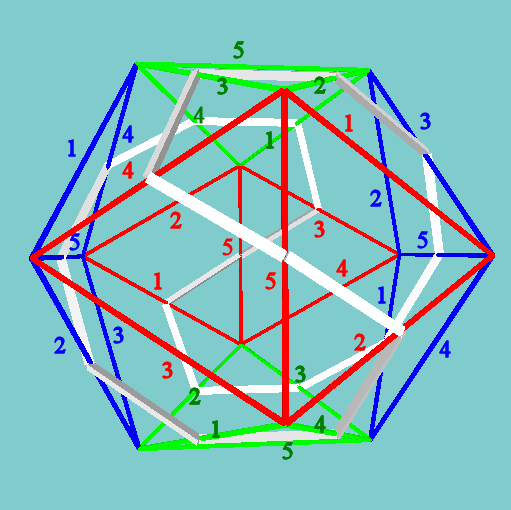 |
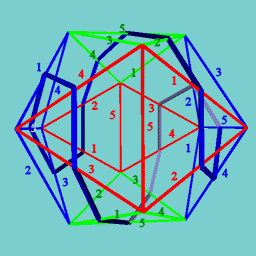 |
|
R_5 +Winding_0 in Reference Frame |
Now to start the rules on how this mechanism works the five +Winding_0s that ARE NOT among those that can be picked by the small cards from Quarter 1 will be shown. These will include the original Winding_0 R_5 (shown above) to which the specific Quarter belongs. While it may be argued that it shares Face Vectors with itself, the word "share" implies the participation of a separate Winding and it is not a separate Winding from itself.
Next, the two Winding_0s mutually perpendicular to R_5 and each other as shown and extensively shown and discussed in Chapter 1, because not only do they not share Face Vectors with not only Quarter I, but the rest of R_5 as well! These two Winding_0s use Centering Edge 5 of their respective colors:
|
|
|
|
B_5 |
G_5 |
The last two Winding_0s to be eliminated are CE_B_1 and CE_G_4. While it can be seen they do not share Face Vectors with the specific Quarter 1, they DO share Face Vectors with the other three Quarters even though this may not obvious in the images:
|
|
|
|
B_1 |
G_4 |
Now the remaining 10 Windings that do share Cross Vectors with Quarter 1 will be shown. Since Quarter 1 has five Faces and there are four possible Faces sharing the same Vector with each of those five, then twenty faces share the Vectors. However, since only ten Winding_0s are available, then some Winding_0s will share more than one Face Vector with the Quarter. This means there is an acknowledged bias for one Winding_0 to get picked over another with in each specific Quarter. However, reiterating, Center Edge color coding system and its Reference Frame is only relative to Quarter 1 of R_5 Winding_0 (the Master Quarter Orientation), so if Quarter 1 is rotated to any other Quarters 2, 3 and 4 than that bias will change. When the biases of all four Quarters are taken into account then all fifth teen +Winding_0s will share an equal chance within the icosahedron. This system is played and developed as it exists and such biases are accepted as part of the scheme of things.
In the following cataloging the capital letter descriptions above matches the below images caption left to right. In the images gold Face numbers belong to the shown +Winding_0, while white Face numbers belong to Q_1.
A. R_1 Faces II, III and V respectively share Face Vectors with Q_1 Faces I, II, and V.
B. G_2 Face III shares one Face Vector with Q_1 Face I.
C. B_2 Face IV and II respectively share Face Vectors with Q_1 Faces I and IV:
|
|
|
|
|
A. R_1 |
B. G_2 |
C. B_2 |
D. B_3 Faces V, I and I respectively share Face Vectors with Q_1 Faces I, IV, and V.
E. R_4 Faces I and II respectively share Face Vectors with Q_1 Face II and III.
F. B_4 Face IV shares one Face Vector with Q_1 Face II:
|
|
|
|
|
D. B_3 |
E. R_4 |
F. B_4 |
G. R_2 Faces V and III respectively share Face Vectors with Q_1 Faces II, and V.
H. Z_3 Face I shares one Face Vector with Q_1 Face III.
J. Z_1 Faces IV and III respectively share Face Vectors with Q_1 Face III and IV:
|
|
|
|
|
G. R_2 |
H. Z_3 |
J. Z_1 |
I. R_3 Faces V and IV respectively share Face Vectors with Q_1 Face III and V:
|
|
|
I. R_3 |
Hypothetically establishing one of these ten Winding_0s for use in the system would simply start out as using the element of a small card to establish a Quarter and then using its numerical value to count and land on the Cross Vector that the new Winding_0 shares. However, the images below illustrate some questions that arise such as "Count in which direction?"
|
Count from Face I to Face V? |
-OR- |
Count from Face V to Face I? |
|
|
|
Another similar but more complex question also arises. Which order should the count be done with regards to the four Winding_0s that share the particular Cross Vector? Count up from I to V or down from V to I? As an example, the images below demonstrate this order question for the Cross Vector of Face I:
|
Which Order for Face I: Up from II to V? |
|
|
|
-or Down from V to II? |
|
|
These direction and order questions generates two permutations each, so once again there is yet another quaternary. This quaternary will be described using the following short hand for increment and decrement of direction respectively: "++" and "- -". As well as these abbreviations for order and direction respectively: "Ord" and "Dir":
1. Ord++, Dir++
2. Ord--, Dir++
3. Ord--, Dir--
4. Ord++, Dir--
This new quaternary combines with the element Quarter quaternary to produce yet another 4 x 4 matrix and therefore the mechanism is more complex than the initial and simple use that a small card element allows for. While potentially the new quaternary element could be established using the zodiac element, the sixteen element matrix of the court cards could also be used here and replace the small card element. Both the court card and zodiac/small cards element systems are possibilities here.
Starting with Quarter 1 as a working example, four tables for the possible combinations are shown below. Simply look for "Start" and follow the increasing small card numbers one (ace) through ten and then repeating. The new Winding_0 achieved is listed directly below the small card's number:
|
|
|
|
1. Ord++, Dir++ |
2. Ord--, Dir++ |
|
|
|
|
3. Ord--, Dir-- |
4. Ord++, Dir-- |
But which chart is suppose to be used? To answer that question a set of four sigils is needed to correlate/bind the charts to the four elements, so the particular chart chosen will be based on a previously established element matching the sigil of an element. The basis for these new sigils will be the sigil for Quarter 1 constructed at the end of Chapter 2:
|
|
|
Quarter 1 Sigil |
The sigils need to represent each of the four possibilities contained within incrementing or decrementing the order and direction. This will be done by rotating the sigil's order starting Face to its direction starting Face. Hypothetically Face I and Face V would represent increment and decrement respectively, because incrementation starts with the lowest number (I), while decrementation would start with the highest (V). Face I and Face V should also ideally represent the initial starting places for order and direction as well. However, this obvious approach demonstrated an interesting problem because the rotated sigils for Chart 2. (Ord--, Dir++) and Chart 4. (Ord++, Dir--) were exactly the same! In the case of Chart 2 an incrementing direction starts at Face I and a decrementing order starts at Face V, so Face V would be rotated to Face I. In case of Chart 4 with a decrementing direction starting at Face V and incrementing order starting at Face I, Face I would be rotated to Face V. The problem can be glimpsed on the charts at the far upper right corner direction Face V (in white) at order Face I (in gold) lists the Winding_0 as B_3, and likewise at the opposite far lower left corner direction Face I (in white) at order Face V (in gold) also lists the Winding_0 as B_3.
However, attempting to describe the problem in words is no match for an animation that shows the root problem. The entire Quarter composed of Cross Vectors will be rotated 180 degrees around the axis of the yellow cylinder so that the red Cross Vector of Face I will move to the original position of the blue Cross Vector of Face V:
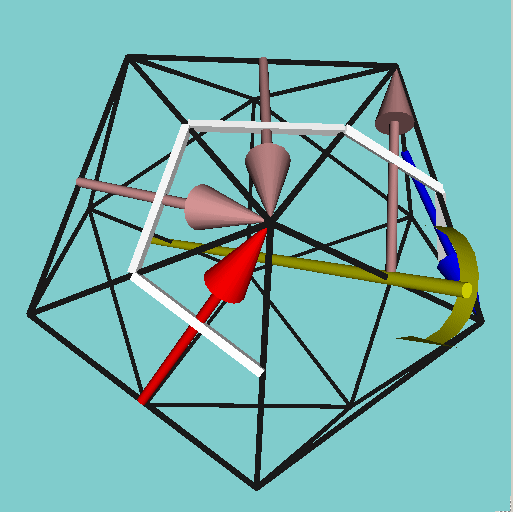 |
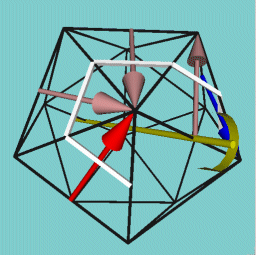 |
| Compare the image above with the animation's final position (to the right). |
After the animation is run, it can be seen that the red and blue vectors switch positions and therefore achieve an identity and that is why the two sigils for Charts 2 and 4 are identical. This ability for Cross Vectors (or Terminal Vector) to achieve an identity by swapping exact positions will be an underlying feature in upcoming chapters. It also dovetails with this chapter's summation and the comparison with tuning in music -the two Cross Vectors are a visual unison!
But in terms of creating sigils, the rotation positions of Face I -> Face V and Face V -> Face I cannot be used, so the next order/direction steps will be used: Face II -> Face V and Face IV -> Face I. The rotation positions for other two sigils will be: Face II -> Face I and Face IV -> Face V.
Next, animations of the rotations needed to construct the for new sigils will be shown. On the left will be an image showing the two vectors involved as well as the ISH_Winding_0. The smaller center image is the animation shown in a downward view to maximize clarity and the color of the Quarter I section belonging to ISH_Winding_0 has been changed to black. On the right is a direct top view of the new sigil in its rotated position with the two Cross Vectors merged as one.
Sigil for Chart 1. as Face II -> I for Ord++, Dir++ :
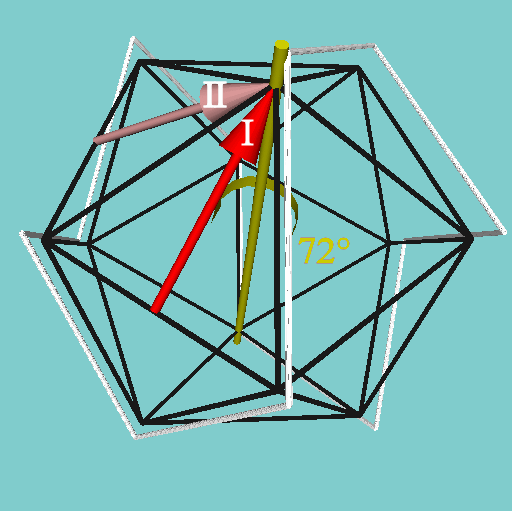 |
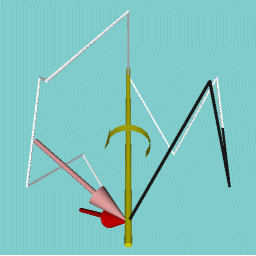 |
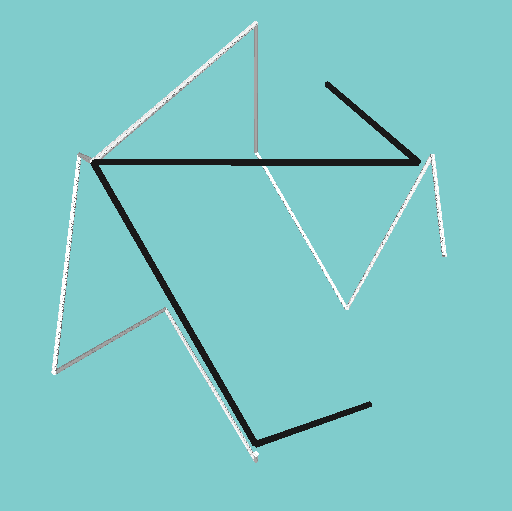 |
| Top View of Rotated Quarter I |
Sigil for Chart 2. as Face IV -> I for Ord--, Dir-++ :
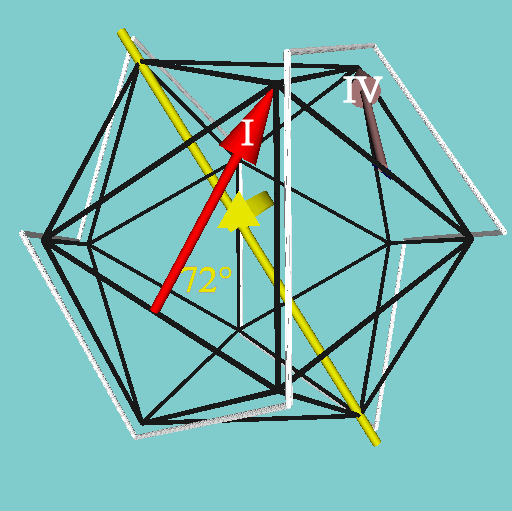 |
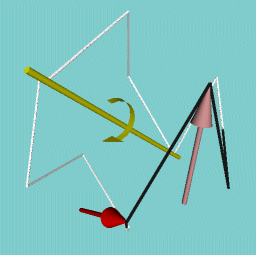 |
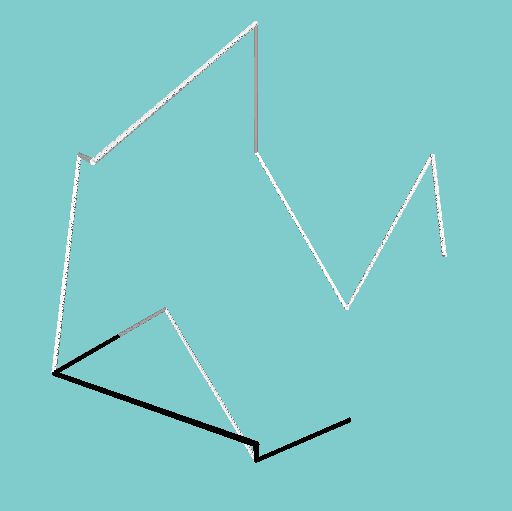 |
Sigil for Chart 3. as Face IV -> V for Ord--, Dir-- :
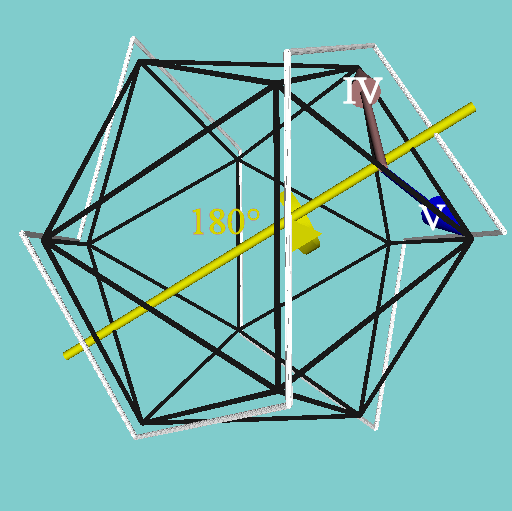 |
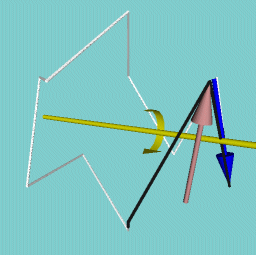 |
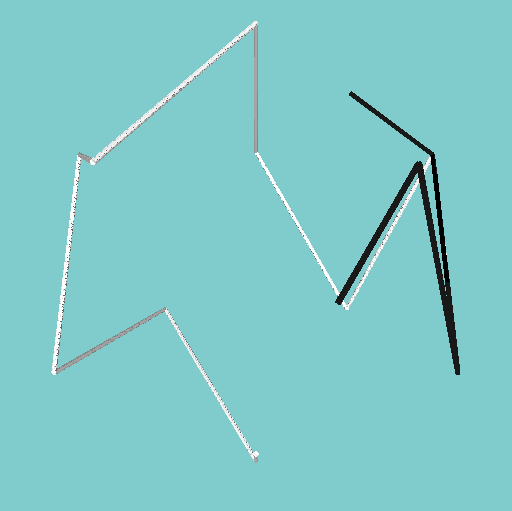 |
Sigil for Chart 4. as Face II -> V for Ord++, Dir-- :
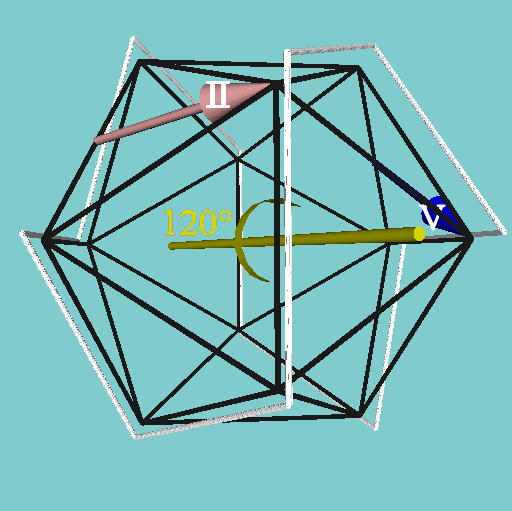 |
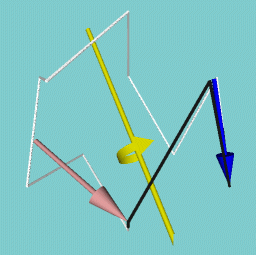 |
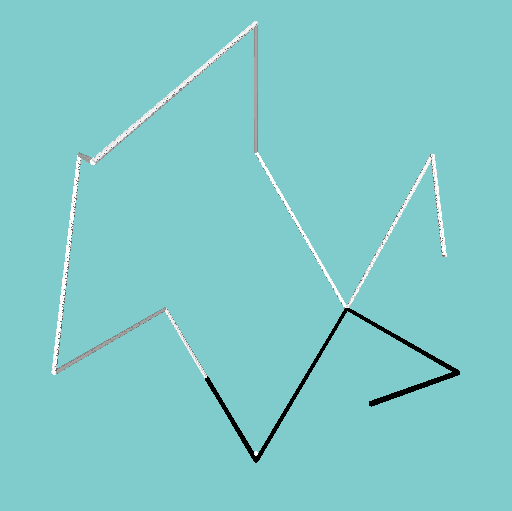 |
The four resulting Chart sigils shown together and subjectively color coded the four elements using the Islamic system:
|
|
|
Chart 2. |
Chart 1. |
Chart 3. |
Chart 4. |
Finally, here is a working example for the relevant part of "reading situation" so far with these selected cards and geometry:
1. Operating from this particular +Winding_0 (It had been obtained using a previous New Winding_0 Selection Process):
|
|
2. The Moon card is the Major Arcana card. Its astrological sign is Pisces, which is of the element water. Using the Quarter sigil system developed in Chapter 2, Quarter 3 is shown to be the element water:
|
|
2. The small card is the five of swords, so it is the element air and consequently uses Chart 4:
|
|
|
|
Element Air Sigil as Face II -> V for Ord++, Dir-- uses Chart 4. |
Chart 4. Ord++, Dir-- |
The original +Winding_0 with its Quarter 3 (below left) is now revolved so Quarter 3 is in the Master Quarter Orientation of the Reference Frame (below right). Since it was the five of swords that is the small card, then Chart 4 (on the upper right) shows the Centering Edges for the new +Winding_0 to be R_1 (again below right).
|
|
|
Finally, the +Winding_0 and Reference Frame is revolved back to +Winding_0's original position (below right) in order to indicate the real position of R_1.
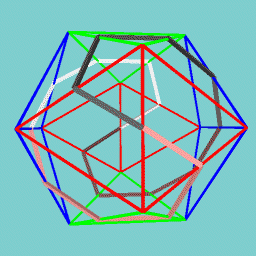 |
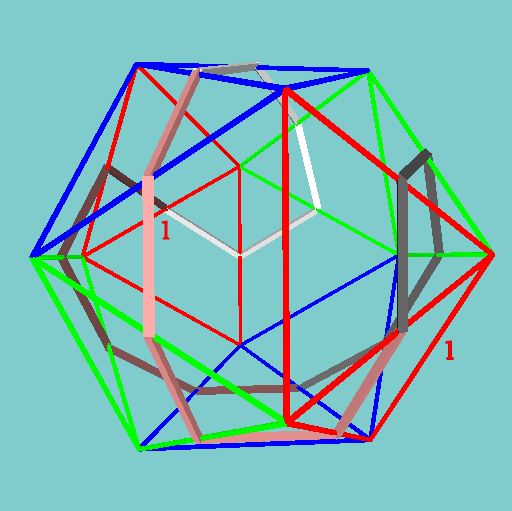 |
R_1 is now the Centering Edge of the new +Winding_0:
|
|
Three examples are demonstrated below of the many possible TVS 0 Configs that can be constructed using the TVS's of the twelve windings. The first two examples are +Windings' TVS's building a +Winding _0, while the third is -Windings' TVS's building a +Winding_0. The titles are also bookmark links back to the original image definitions above. Also on the images that are the 3D corollaries to the flattened 2D views, the color of the vector arrows have been changed from blue to the color of the winding to which they belong.
Example 1. TVS 0 Config_1_10:
|
|
|
|
|
Flattened +Winding_0 with Terminal Vectors of +Windings 3, 5, and 8 added: |
3D View: |
|
|
|
|
|
|
|
|
Flattened +Winding_0 with Terminal Vectors of +Windings 2, 4, and 6 added: |
3D View: |
|
|
|
|
|
|
|
|
Flattened +Winding_0 with Terminal Vectors of +Windings 1, 11, and 12 added: |
3D View: |
|
|
|
|
|
|
|
|
Flattened +Winding_0 completed with Terminal Vectors of +Windings 7, 9, and 10 added: |
3D View: |
|
|
|
Example 2. TVS 0 Config_5:
|
|
|
|
|
Flattened Winding_0 with Terminal Vectors of Windings 4, 6, and 9 added: |
3D View: |
|
|
|
|
|
|
|
|
Flattened +Winding_0 with Terminal Vectors of +Windings 1, 10, and 12 added: |
3D View: |
|
|
|
|
|
|
|
|
Flattened +Winding_0 with Terminal Vectors of +Windings 2, 3, and 7 added: |
3D View: |
|
|
|
|
|
|
|
|
Flattened +Winding_0 with Terminal Vectors of +Windings 5, 8, and 11 added to complete: |
3D View: |
|
|
|
The Unique Group of negative Windings have bookmark links to their new image/definitions in the main text body above, while the Reflective Group have links to the positive Winding that echoes the particular TVS. A special case is made in the case of the reflective Windings -1 and +7 because of the Winding_7 capability of two positions for any particular TVS. The TVS designation for -Winding_1 to +Winding_0 is the larger of the pair of +7 TVS designations divided by two, while -Winding_7 is given TVS's designation of +1 TVS a and (a + 1).
|
|
|
|
|
Flattened +Winding_0 with Terminal Vectors of -Windings 4, 6, and 12 added: |
3D View: |
|
|
|
|
|
|
|
|
Flattened +Winding_0 with Terminal Vectors of -Windings 1, 5, and 8 added: |
3D View: |
|
|
|
|
-10 -> +0 TVS 2: | ||
|
|
|
|
|
Flattened +Winding_0 with Terminal Vectors for -Windings 3, 9, and 10 added, but 10 can be dropped out: |
3D View: |
|
|
|
|
|
|
|
|
Flattened +Winding_0 with Terminal Vectors of -Windings 2, 7, and 11 added, but 2 can be dropped and transposed to any of its other 4 TVS's: |
3D View: |
|
|
|
This appendix will show the TVS's total for -Windings in relation to +Winding_0. It is included for documentation purposes for possible use in the system and is therefore "on the back burner" in terms of actual inclusion.
First the grand total based on numerical order:
|
-Winding_1: |
6 |
|
-Winding_2: |
4 |
|
-Winding_3: |
4 |
|
-Winding_4: |
2 |
|
- Winding_5: |
12 |
|
-Winding_6: |
6 |
|
-Winding_7: |
4 |
|
-Winding_8: |
6 |
|
-Winding_9: |
6 |
|
-Winding_10: |
2 |
|
-Winding_11: |
4 |
|
-Winding_12: |
_6 |
|
Total: |
62 |
The total is sixteen less than the seventy-eight for TVS's of the same handedness, so it seems that while any court card correlation maybe lost, a correspondence of twenty-two Major Arcana and forty small cards might still exist. However, there does not seem to be any further corresponding break down. Their analog Unique Group and Reflective Group totals are not useful, nor is a break down by symmetry and asymmetry. At end of the day though, it must be realized that WITHOUT the existence of these relationships the Major Arcana's 22 and Minor Arcana's 56 break-downs of the original 78 TVS's total would never have been revealed! Hypothetically they may represent an opportunity for the system to step outside its "box" and such an ability would be the hallmark of intelligence. The tables below will require more study:
|
|
|
|
|